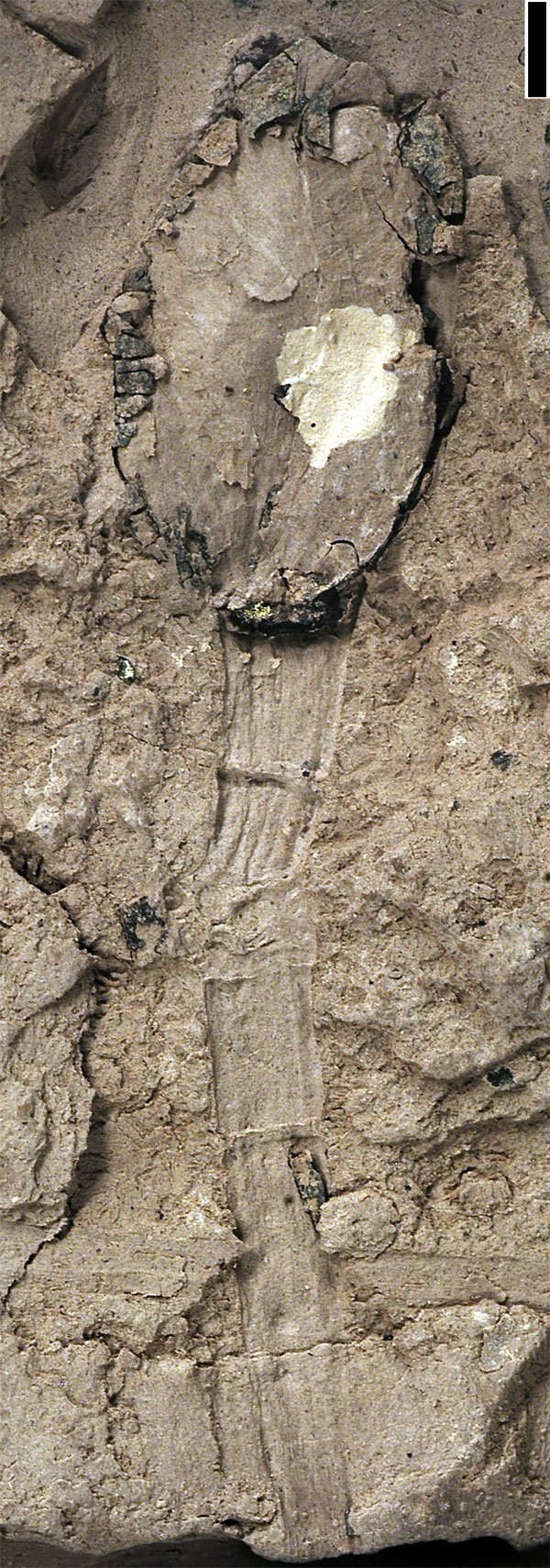FIGURE 1. Map showing the location of the Warman clay pit, Tennessee, USA.
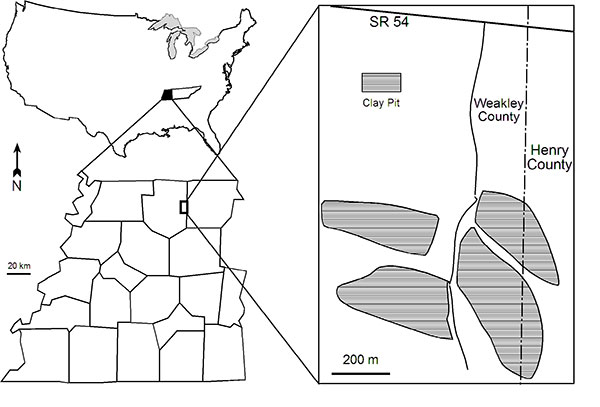
FIGURE 2. Simplified stratigraphic column of the Paleocene Wilcox Group and the Eocene Claiborne Group in the Upper Mississippi Embayment of southeastern United States. "?" indicates that the contact between two formations cannot be reliably defined based upon available information (Parks and Carmichael, 1990).

FIGURE 3. Lauroflorum warmanensis gen. et sp. nov. All scale bars equal 1 mm except for the bar in Figure 3.3, which equals 0.5 mm. 1. UF15826-51527. Laterally preserved flower. Note long pedicel (indicated by lower arrow) and glands (indicated by upper arrow). 2. UF15826-33558. Laterally preserved flower showing three perianth parts and clustered glands (indicated by arrow). 3. Enlargement of Figure 3.2 showing clustered glands (indicated by arrow). 4. UF15826-2237. Vertically preserved flower showing six perianth parts (arrow at the bottom inciates the sixth perianth part). 5. UF15826-51953. Vertically preserved flower showing six perianth parts. Note one mid-vein and two parallel thinner veins in each part, and scattered glands on the perianth parts (indicated by arrows). 6. UF15826-49563. Laterally preserved flower showing perianth parts. 7. Counterpart of Figure 3.6 showing a long pedicel. 8. UF15826-33556. Laterally preserved flower showing long pedicel, perianth parts and clustered glands (indicated by arrow).
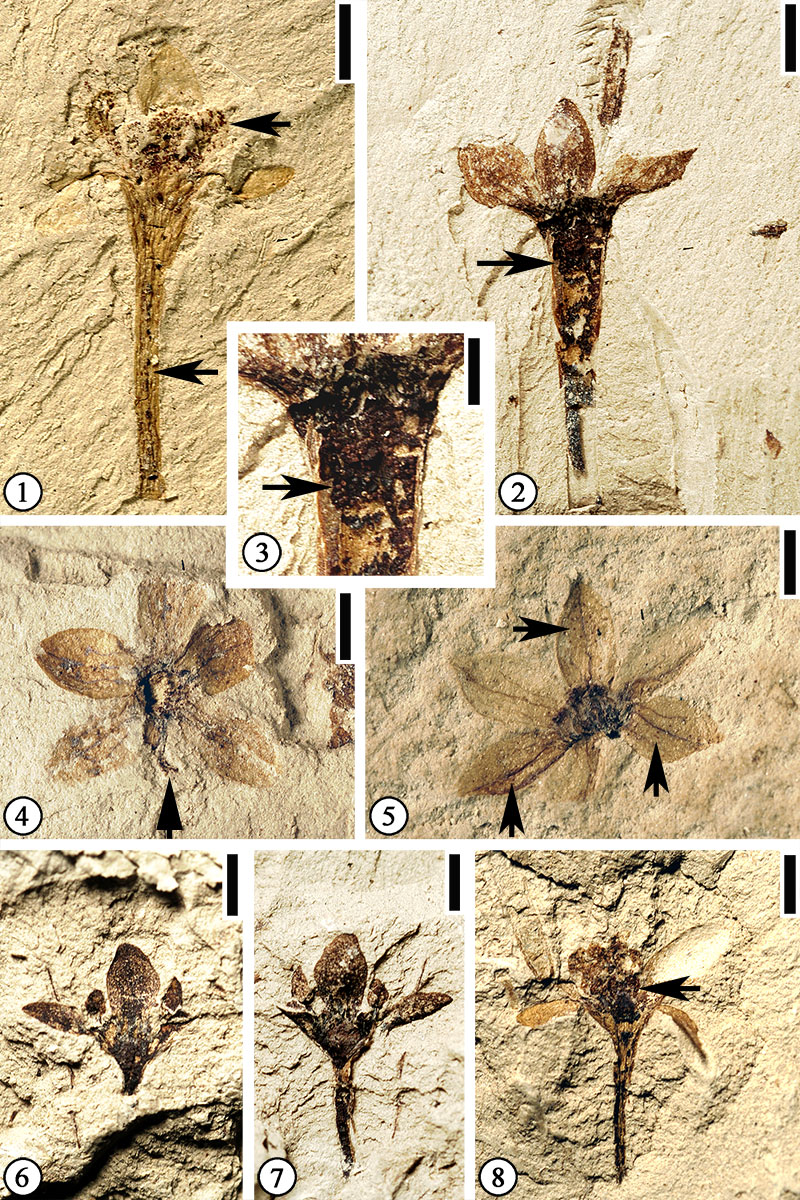
FIGURE 4. Anonaspermum robertsi (Berry) comb. nov. 1. UF15826-33565. Note the relatively smooth seed testa and a reniform seed. Scale bar = 4 mm. 2. UF15826-30837. Note the central line of endosperm (indicated by the arrow). Scale bar = 2 mm. 3. UF15826-51266. Note the thick seed testa. Scale bar = 3 mm. 5. Counterpart of Figure 3.3. Note the thick seed testa. Scale bar = 3 mm. 6. UF15826-53986. Scale bar = 4 mm. 7. UF15826-51289. Scale bar = 3 mm. 8. UF15826-51297. A typical reniform seed. Scale bar = 3 mm. Anonaspermum warmanensis sp. nov. 4. UF15826-51284. Note the spiny ruminations (indicated by the arrows). Scale bar = 2 mm.
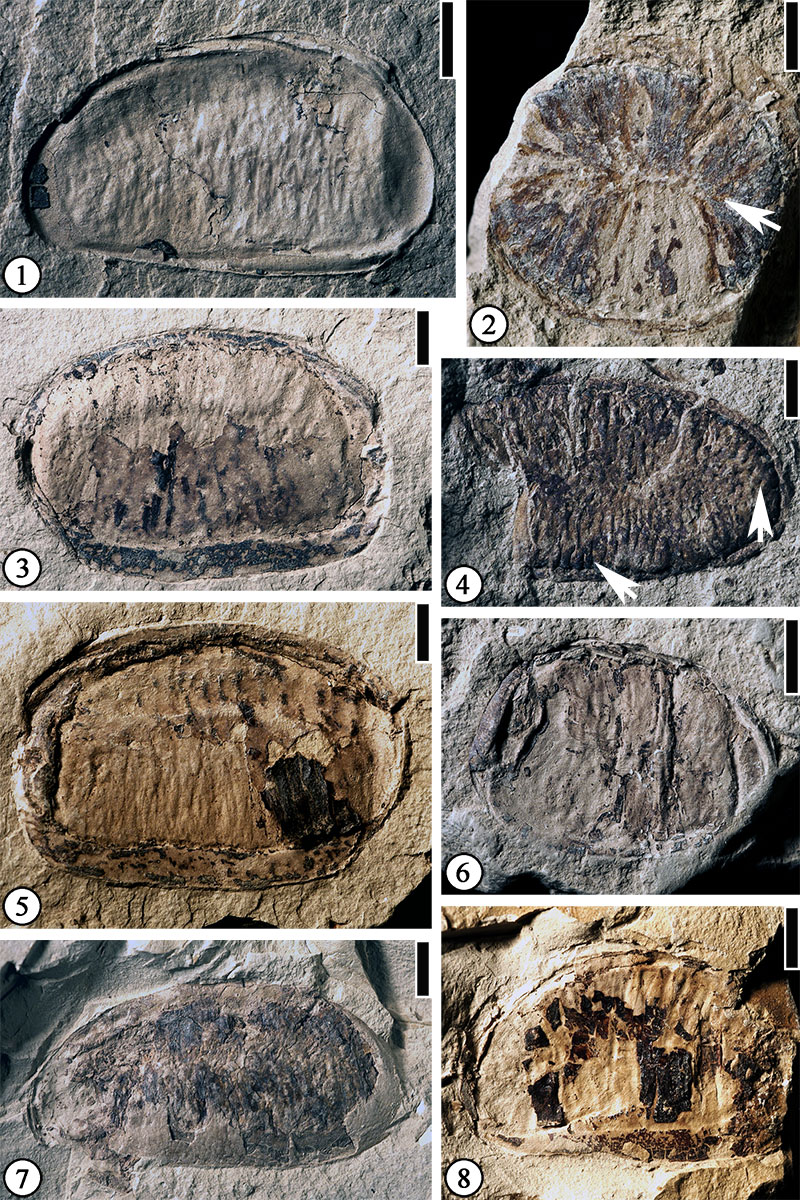
FIGURE 5. cf. Magnolia sp. UF15826-51344. An elliptic seed with a thick testa. Scale bar = 0.5 mm.
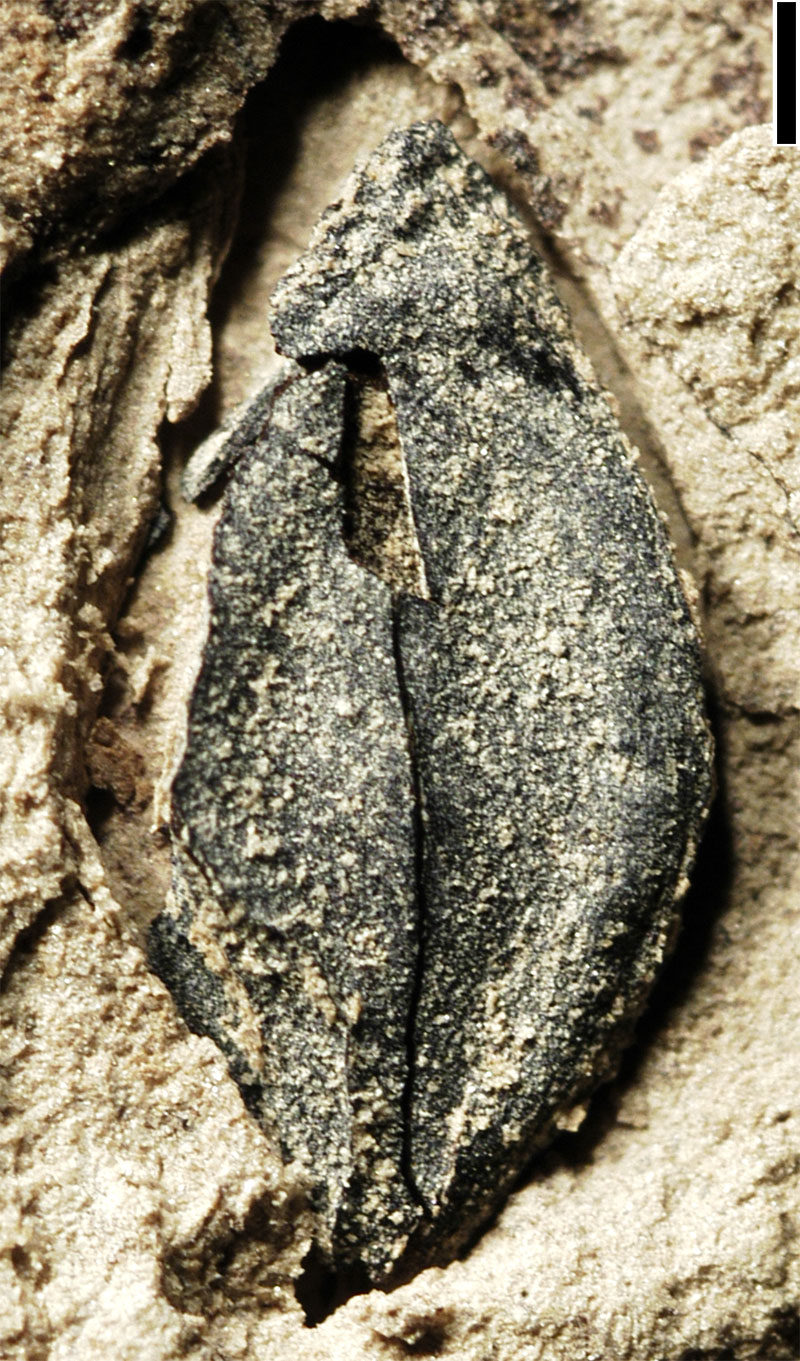
FIGURE 6. cf. Acorites heeri Crepet. UF15826-33571. An incomplete "spadix" showing helically arranged floral parts. Scale bar = 1 mm.

FIGURE 7. Altingiaceae Infructescence.1. UF15826-33568. Showing the fruits of an infructescence. Scale bar = 2 mm. 2. UF15826-33569. Showing two pedunculate infructescences. Note the long peduncles. Scale bar = 3 mm.
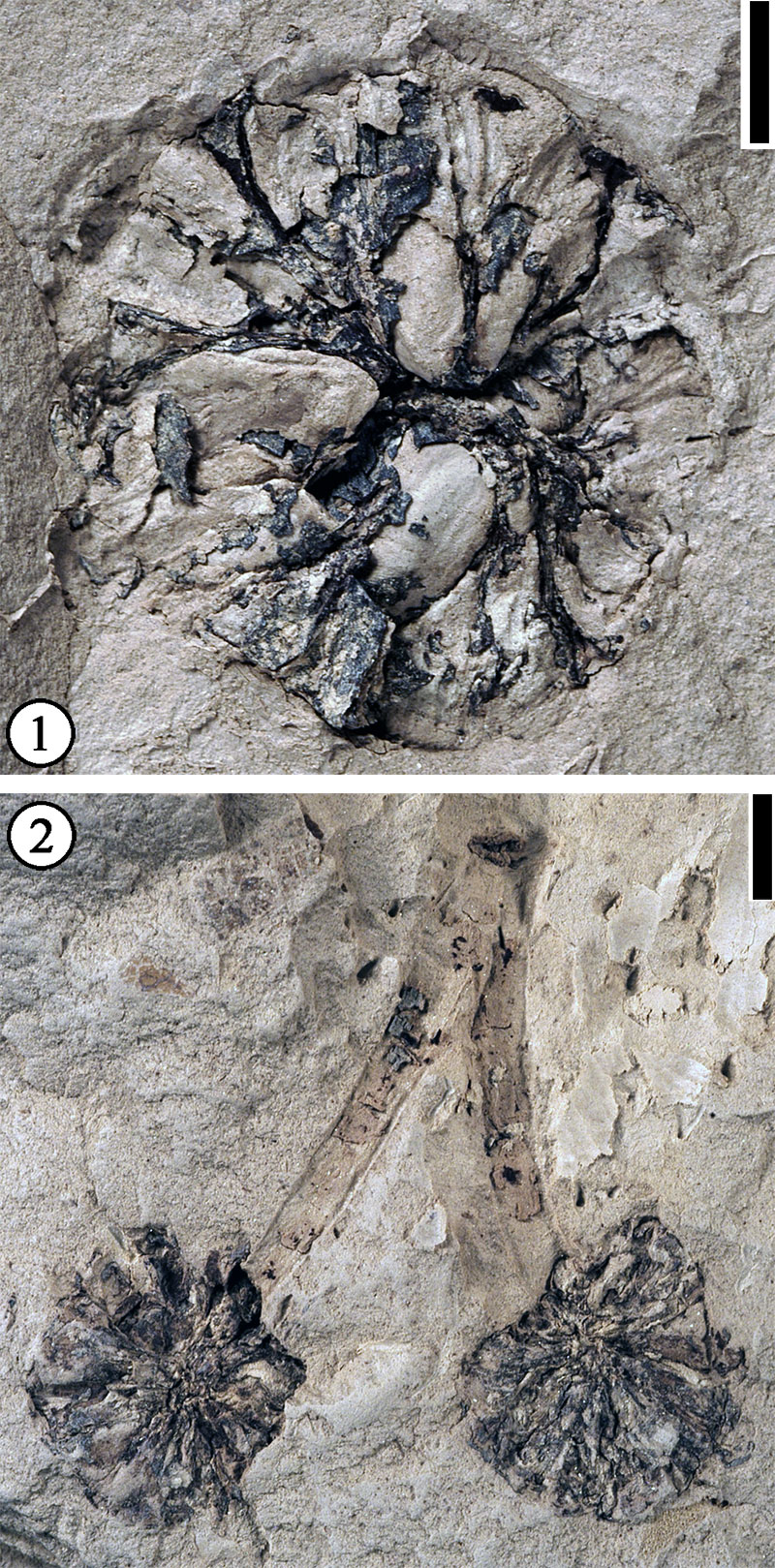
FIGURE 8. Corylopsis grotei sp. nov. All scale bars equal 1 mm. 1. UF15826-9111. Showing an asymmetric hilum with two arms (indicated by arrows). 2. Opposite side of Figure 8.1. 3. UF15826-9056. Showing the longer arm of an asymmetric hilum scar (indicated by arrow). 4. Opposite side of Figure 8.3 showing the shorter arm of an asymmetric hilum scar (indicated by arrow).
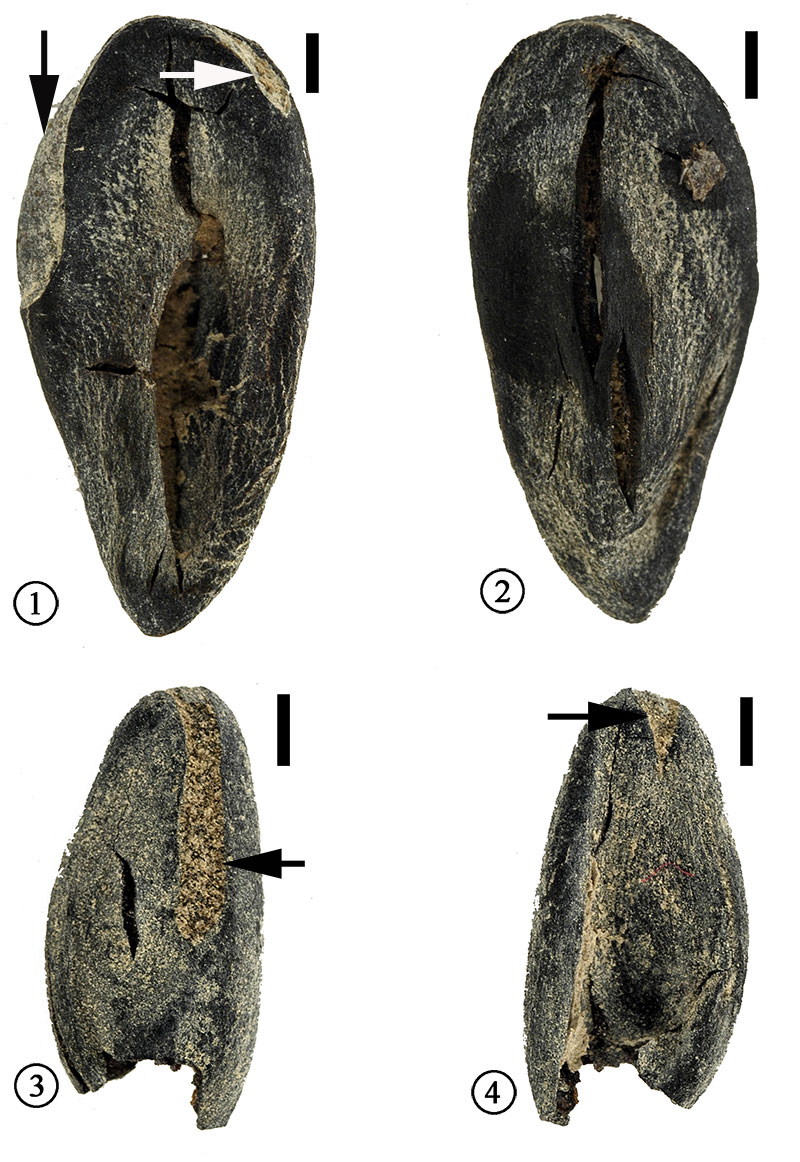
FIGURE 9. Hamamelis warmanensis sp. nov. 1. UF15826-33567. Showing two fruits with long peduncles attached to the stem. Scale bar = 6 mm. 2. Enlargement of Figure 9.1 to show stylar projections (indicated by two upper arrows) and capsule valves (indicated by two lower arrows). Scale bar = 4 mm. 3. Enlargement of Figure 9.1 to show another fruit. Note the demarcation between the lower cupule and the upper fruit body (indicated by arrows). Scale bar = 4 mm.

FIGURE 10. Eomimosoidea plumosa Crepet and Dilcher. 1. UF15826-33564. Showing an incomplete catkin. Arrow indicates a flower enlarged in Figure 10.4. Scale bar = 6 mm. 2. Counterpart of Figure 10.1 showing nearly complete length. Scale bar = 6 mm. 3. Enlargement of two dispersed anthers in Figure 10.2 (indicated by top arrow) showing a globose anther and longitudinal dehiscence. Scale bar = 0.5 mm. 4. Enlargement of a flower in Figure 10.1 (indicated by the arrow) showing a floral envelope (fe), a style and a stigma (s), and filaments (f). Scale bar = 0.5 mm. 5. Enlargement of a flower in Figure 10.2 (indicated by the bottom arrow) showing a floral envelope (fe), filaments (f), and dispersed anthers (a). Scale bar = 0.5 mm.

FIGURE 11. Eomimosoidea plumosa Crepet and Dilcher. 1. UF15826-51518. An incomplete catkin. Scale bar = 5 mm. 2. Enlargement of Figure 11.1 showing dispersed anthers (a), a style and a stigma (s) of a flower. Scale bar = 1 mm. 3. UF15826-51387. An incomplete catkin showing calyx (c), and a style and a stigma (s) of a flower. Scale bar = 1 mm. 4. UF15826-51348. An incomplete catkin showing attached and dispersed sessile flowers. Arrow indicates the flower enlarged in Figure 11.5. Scale bar = 3 mm. 5. Enlargement of a flower in Figure 11.4 showing a style and a stigma (s), and filaments (f). Scale bar = 1 mm.

FIGURE 12. Protomimosoidea buchananensis Crepet and Taylor. All bars = 1 mm. 1. UF15926-33554. A laterally compressed flower showing filaments (f), valvate petals (p), and sepals (s). 2. UF15826-33559. A laterally compressed flower with a triangular receptacle (r) and stamens (s). 3. UF15826-51359. A laterally compressed flower showing an ovary (o), a petal (p), a dispersed anther (a), and filaments (f). 4. UF15826-8956. A laterally compressed flower bud showing sepals (s) and petals (p).

FIGURE 13. Swartzia sp. 1. UF15826-9041. A pod showing a narrow flange and a short remnant style . Scale bar = 1 cm. cf. Erythrophleum sp. 2. UF15826-5829. A pod with a stipitate base and impressions of 7 seeds. Scale bar = 1 cm. cf. Leguminosites phyllocarpoides Berry. 3. UF15826-5839. An incomplete pod showing impressions of 6 seeds. Scale bar = 8 mm. Caesalpinia claibornensis Herendeen and Dilcher. 4. UF15826-5853. A pod showing outlines of seed chambers. Scale bar = 7 mm. 5. Base of counterpart of Figure 13.4 showing venation of a valve and a wing. Scale bar = 5 mm. Crudia grahamiana Herendeen and Dilcher. 6. UF15826-5869. A pod showing a marginal suture. Scale bar = 5 mm.
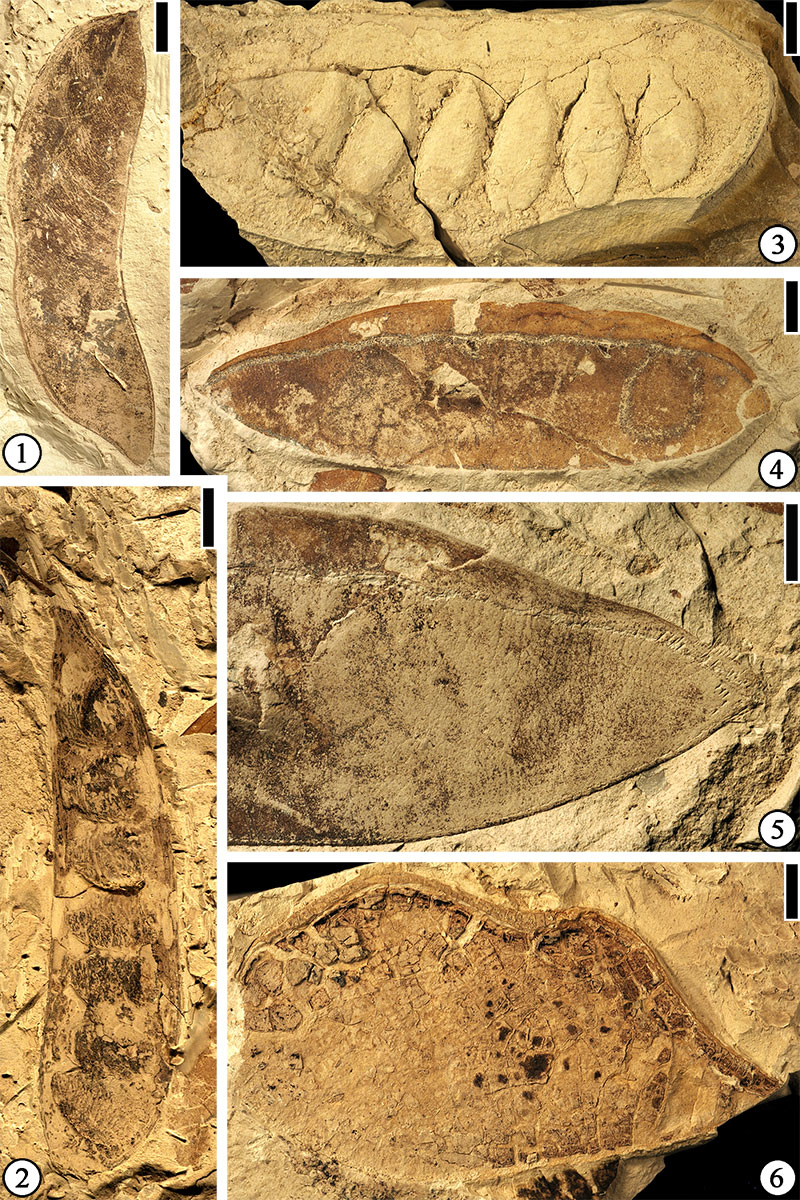
FIGURE 14. Diplotropis claibornensis Herendeen and Dilcher. 1. UF15826-7235. Pod showing three zones (boundaries indicated by arrows) of the fruit. Scale bar = 7 mm. Eliasofructus claibornensis Herendeen and Dilcher. 2. UF15826-5842. Showing outlines of 10 seeds. Scale bar = 1 cm. Gleditsia ? mississippiensis (Berry) Berry. 3. UF15826-7066. Showing thick seed chamber (indicated by arrow). Scale bar = 2 mm. "Thick walled fruit". 4. UF15826-5835. Showing four normal seed chambers and a single small one . Scale bar = 5 mm. Ormosia sp. 5. UF15826-51357b. Showing a young fruit with a pedicel (p), a calyx (c), and valve venation. Scale bar = 3 mm. 6. UF15826-5820. Showing the seed base (b) and three seed chambers. Scale bar = 5 mm.
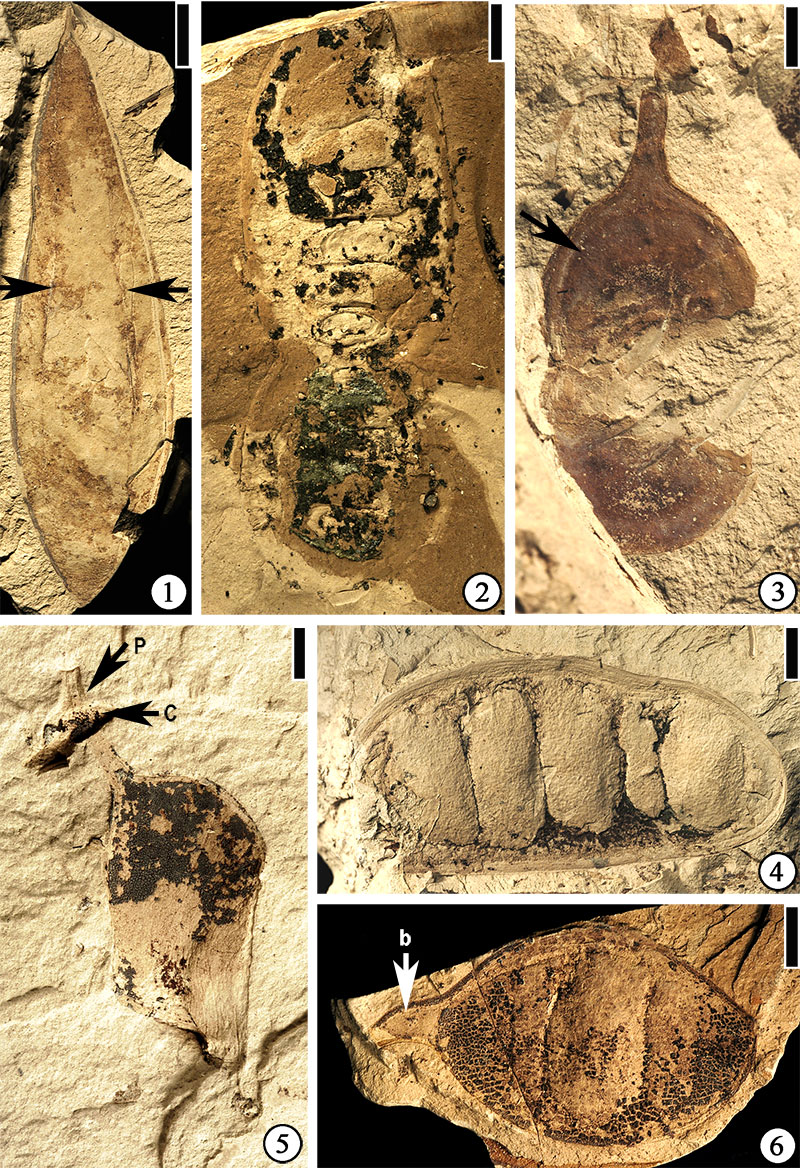
FIGURE 15. Quercus oligocenensis Daghlian and Crepet. 1. UF15826-51481. Showing an incomplete staminate catkin. Scale bar = 2 mm. 2. Enlargement of Figure 15.1 to show a cluster of florets. Scale bar = 0.5 mm. 3. UF15826-51384. Showing an incomplete catkin with at least 8 flower heads. Scale bar = 2 mm.

FIGURE 16. Fagaceous Fruit Type 1. 1. UF15826-51476. Simple and branched spines (appendages). Scale bar = 3 mm. 2. Enlargement of Figure 16.1 to show branched spines. Scale bar = 2 mm. Fagaceous Fruit Type 2. 3. UF15826-51231. Simple spines. Scale bar = 3 mm. Castanea mollissima Blume. 4. UF1248. Extant fruit showing simple spines. Scale bar = 1 cm.

FIGURE 17. Fagaceous Fruit Type 3. 1. UF15826-29216. A long peduncle and thorn-like appendages. Scale bar = 4 mm. 2. Enlargement of Figure 17.1 to show the thorns on the peduncle. Scale bar = 2 mm. 3. Enlargement of Figure 17.1 to show the web-like pattern of the appendages. Scale bar = 1 mm. 4. UF15826-51307. A small fruit; note the intertwining spines. Scale bar = 1 mm.
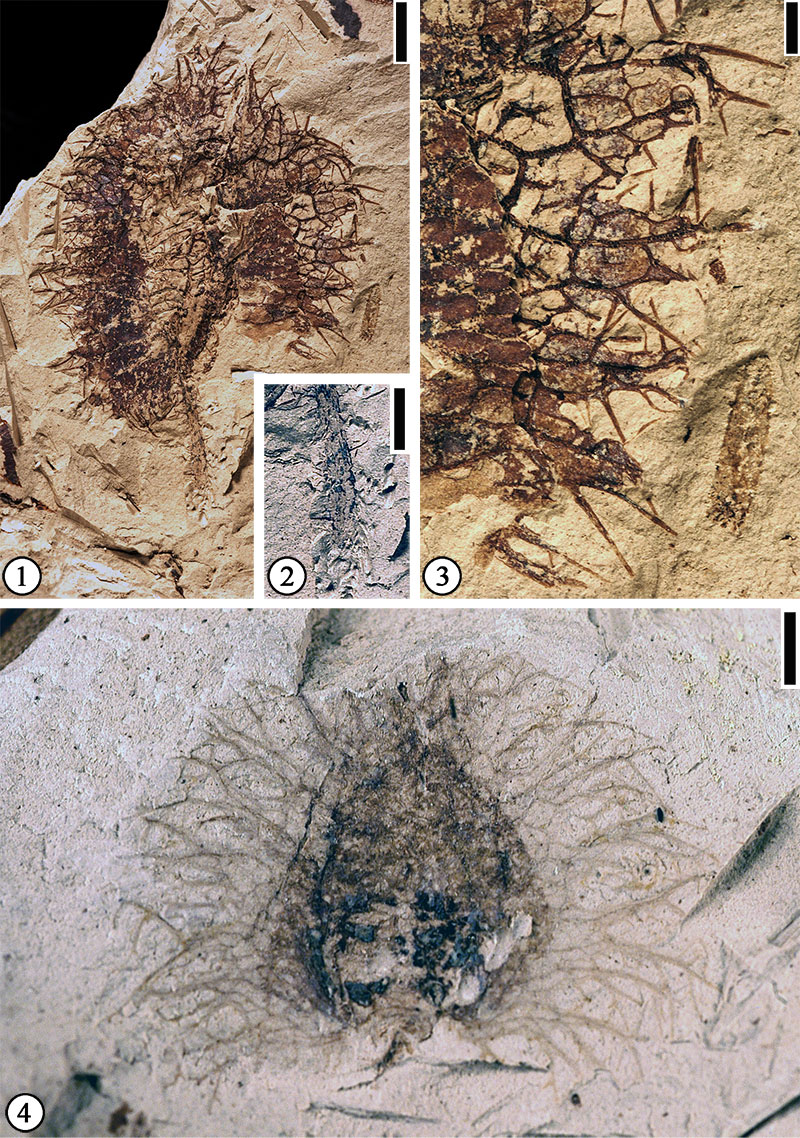
FIGURE 18. Eokachyra aeolius Crepet, Dilcher, and Potter. 1. UF15826-33572. A complete catkin with mature flowers on the proximal portion and immature flowers on the distal portion. Scale bar = 4 mm. 2. Enlargement of Figure 18.1 to show helical arrangement of flowers. Scale bar = 1 mm. 3. UF15826-33573. An incomplete mature catkin. Arrows indicate flowers enlarged in Figure 18.4, 5. Scale bar = 4 mm. 4. Enlargement of flowers from Figure 18.3 (indicated by upper arrow) to show distal perianth (dp), bracts (b), and stamens (s). Scale bar = 1 mm. 5. Enlargement of flowers from Figure 18.3 (indicated by lower arrow) to show perianth (p), bracts (b), and stamens (s). Scale bar = 1 mm. 6. UF15826-33574. An incomplete mature catkin with stamens shed. Scale bar = 4 mm. 7. Enlargement of Figure 18.6 to show a four-lobed bract (b). Scale bar = 1 mm.

FIGURE 19. Paleooreomunnea stoneana Dilcher, Potter, and Crepet. 1. UF15826-1879. A bilobed nut and a tri-lobed wing with well-preserved venation. Note intact sepals (se), prophyllum (p). Scale bar = 5 mm. 2. UF15826-51510. Intact sepals (se) and a prominent septum (sp) dividing the nut compression into two parts. Scale bar = 5 mm.
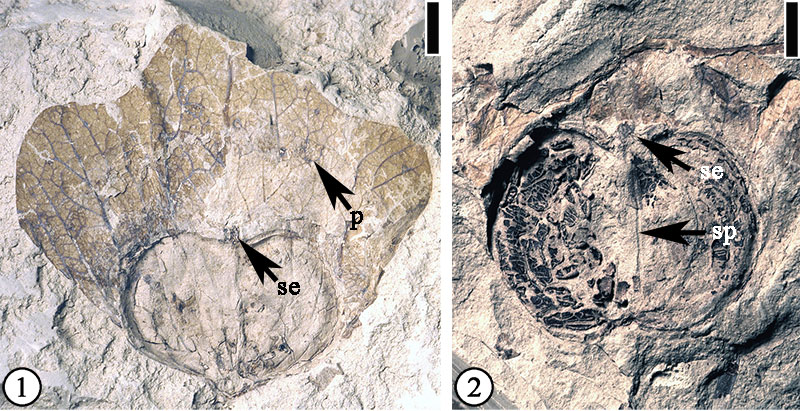
FIGURE 20. Hippomaneoidea warmanensis Crepet and Daghlian. 1. UF15826-51506. An incomplete inflorescence (arrow indicates floral parts enlarged in Figure 20.3). Scale bar = 5 mm. 2. Counterpart of Figure 20. 1. Scale bar = 5 mm. 3. Enlargement of Figure 20.1 to show a dispersed floret (f), a bract (b), and two attached cymules (c). Scale bar = 1 mm.
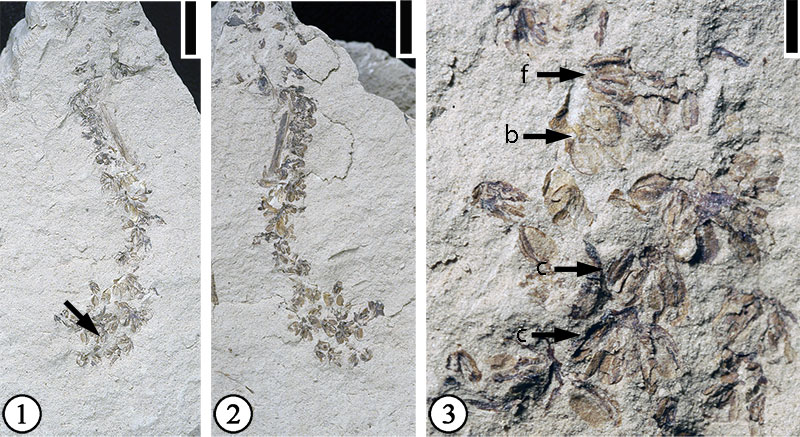
FIGURE 21. Eoglandulosa warmanensis Taylor and Crepet. 1. UF15826-33557. Showing a thickened circular rim (r), floral parts (sepals? - sp), stamens (s), and trichomes (t). Scale bar = 1 mm. 2. Counterpart of Figure 21.1 showing venation of the sepals. Scale bar = 1 mm.
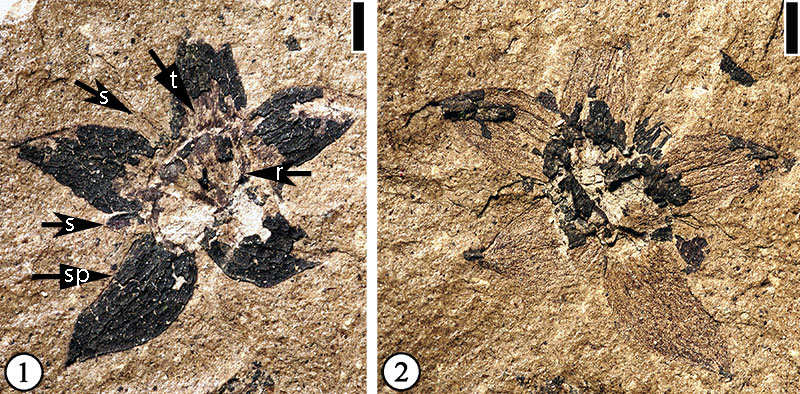
FIGURE 22. Cornerocarpon copiosum Grote gen. et sp. nov. 1. UF15826-51278. Showing the syncarp with "tepals" (t) and embedded fruitlets. A ring of five bracts (b) encircles each fruitlet. Scale bar = 2 mm. 2. UF15826-9198. A compressed specimen showing the proximal side of the syncarp and the peduncle (p). Scale bar = 3 mm. 3. Same specimen as Figure 22.1 cleaned with HF and enlarged to show at least three embeded fruitlets, their bracts (b), and "tepals" (t). Each fruitlet has a ring of five bracts (b). The third fruitlet is indicated by the arrow. Scale bar = 1 mm.
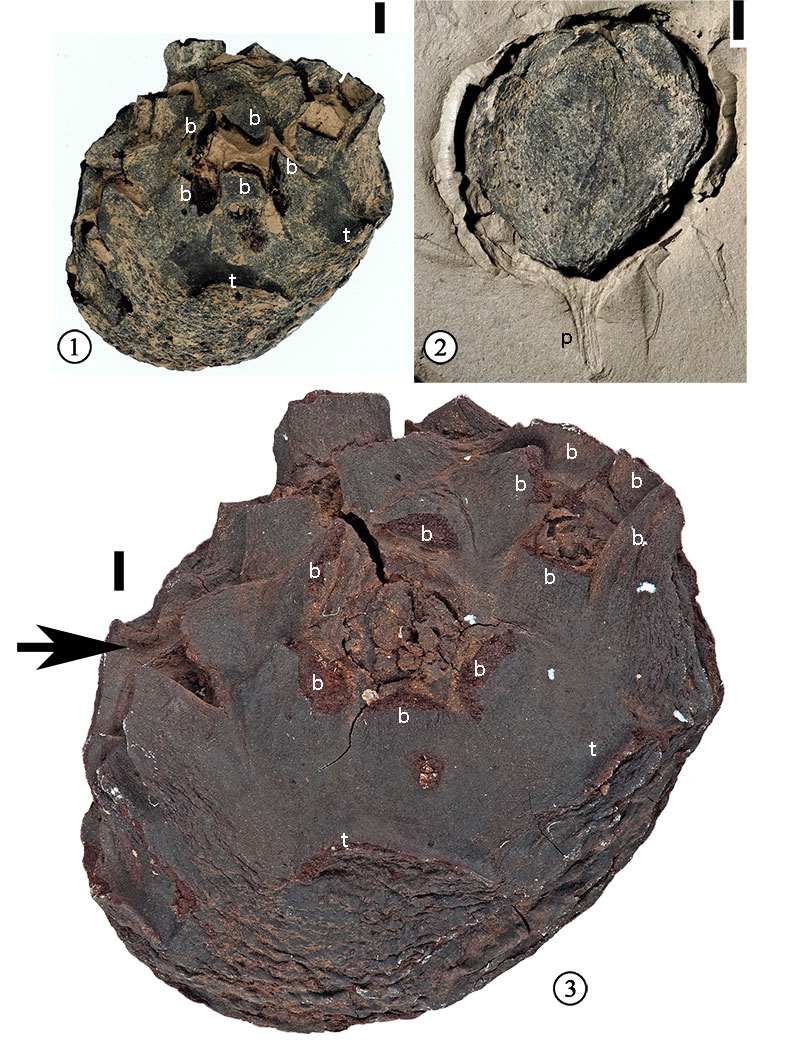
FIGURE 23. Cornerocarpon copiosum Grote gen. et sp. nov. Scale bars = 2 mm. 1. UF15815-9100. A laterally compressed specimen showing three (indicated by numbers) fruitlets. Note the five bracts of fruitlet 1, the ridges (r) on the bracts of fruit 2, and the tepals (t). 2. UF15815-9101. A vertically compressed specimen showing five fruitlets (indicated by numbers), their bracts (b), and the tepals (t). .
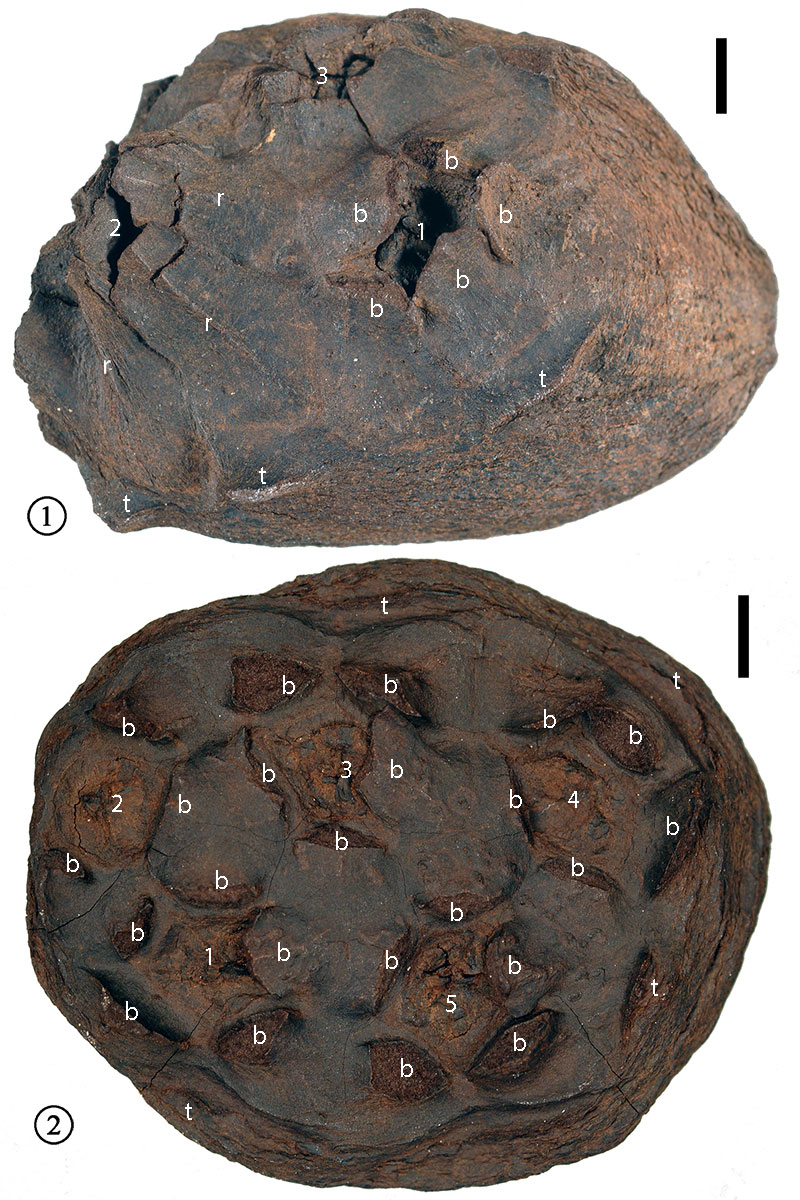
FIGURE 24. Gordonia warmanensis Grote and Dilcher 1992. 1. UF15826-9526. A three-dimensionally preserved five-valved, loculicidally dehiscent capsule. Scale bar = 4 mm. 2. UF15626-52463. A compressed seed. Scale bar = 2 mm. 3. UF15826-51292. A laterally compressed immature capsule. Scale bar = 5 mm. 4. UF15826-51412. A laterally compressed capsule showing a loculicidal dehiscence line (indicated by arrow). Scale bar = 5 mm. 5. Enlargement of the base of the capsule in Figure 24.3 to show oil glands. Scale bar = 1 mm. 6. Enlargement of the apex of the capsule in Figure 24.4 to show four-valved capsule and a dehiscence line. Scale bar = 1 mm.
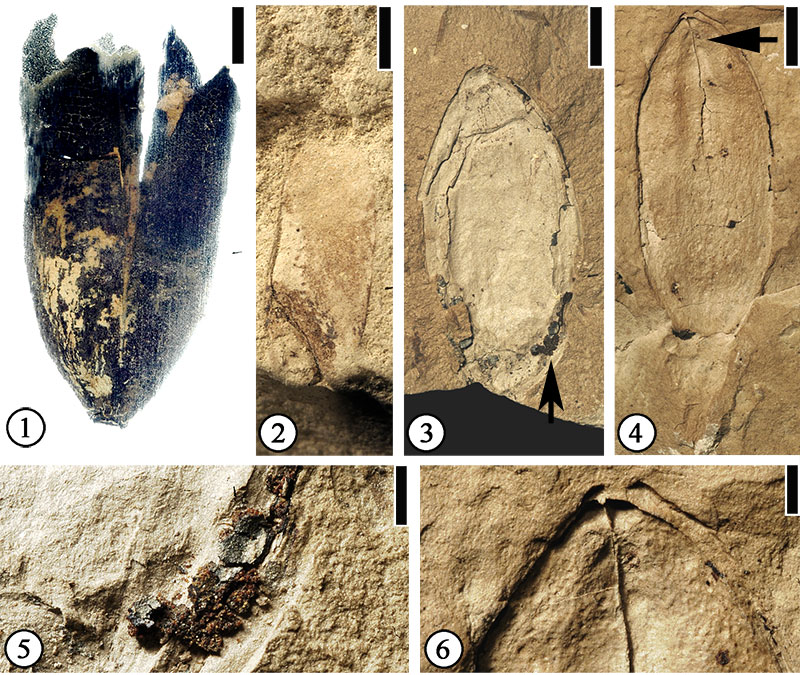
FIGURE 25. cf. Gordonia sp. 1. UF15826-51541. Impression of the base of a flower showing stamen bases (indicated by arrow) and two broken petals. Scale bar = 3 mm.

FIGURE 26. Gordonia sp. 2. 1. UF15826-51405. A laterally compressed flower bud showing no dehiscence. Arrow indicates a bracteole scar. Scale bar = 4 mm. 2. Opposite side of Figure 26.1 showing bracteole scars (bs) and sepal (sp). Scale bar = 4 mm. 3. UF15826-33566. A laterally compressed flower bud showing an apical protrusion (pr) and bracteole scars (bs). Scale bar = 4 mm. 4. Opposite side of Figure 26.3 showing an apical protrusion (pr) and a bracteole scar (bs). Scale bar = 4 mm.
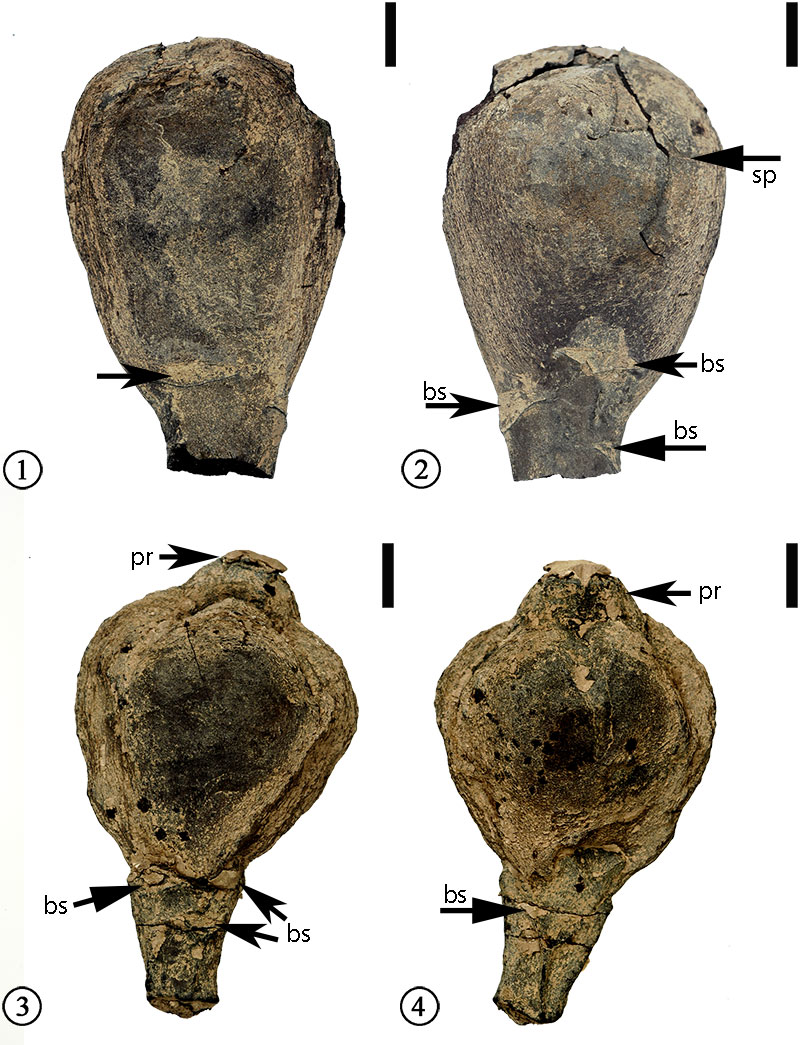
FIGURE 27. Andrewsiocarpon henryense Grote and Dilcher. All scale bars equal 3 mm. 1. UF15826-51407. Top view of a vertically compressed capsule showing loculicidal dehiscence. Scale bar = 3 mm. 2. Opposite side of Figure 27.1 (bottom view) of a vertically compressed capsule showing 5 persistent sepals (indicated by numbers) and pedicel (indicated by arrow). Scale bar = 3 mm. 3. UF15826-51406. A laterally compressed capsule. Scale bar = 2 mm. 4. Opposite side of Figure 27.3 showing dehiscence lines extending about 3/4 of capsule length. Scale bar = 2 mm.
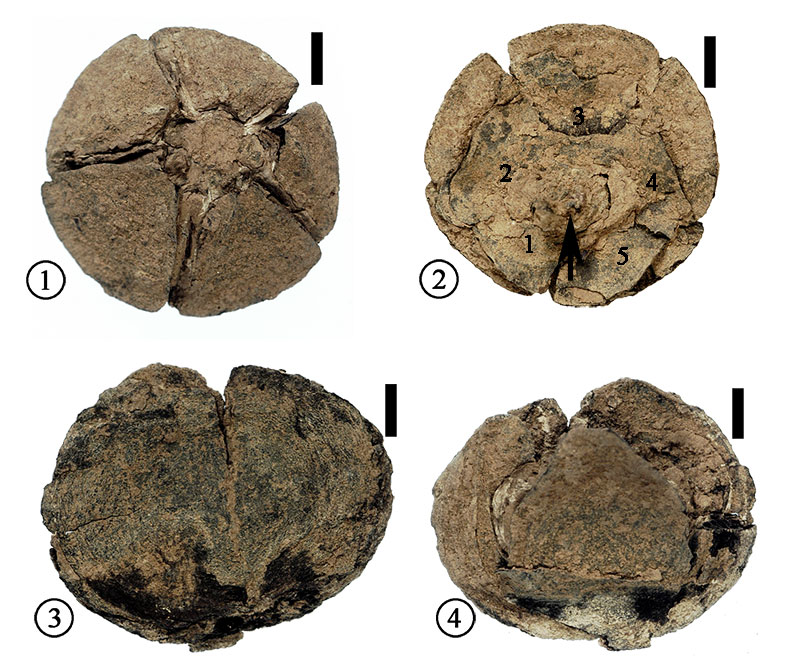
FIGURE 28. Grotea warmanensis sp. nov. 1. UF15826-51212. Outline of the seed showing a two-lobed cotyledon within a circular seed body surrounded by a wing (w) with fine striations. Note the thick seed testa (indicated by upper arrow), the raphe (ra), the hilum scar (indicated by lower arrow), and fine striations in the lower part of the wing. Scale bar = 2 mm. 2. Pithecoctenium crucigerum (Linnaeus) Gentry, collected by J. Blanchard from Honduras, UF2218 (Modern Reference Collection). UF2218 (Modern Reference Colllection). Showing a winged seed. Scale bar = 5 mm. 3. Enlargement of Figure 28.2 to show the cotyledon, the rahpe (ra), the hilum scar (indicated by arrow). Scale bar = 2 mm.
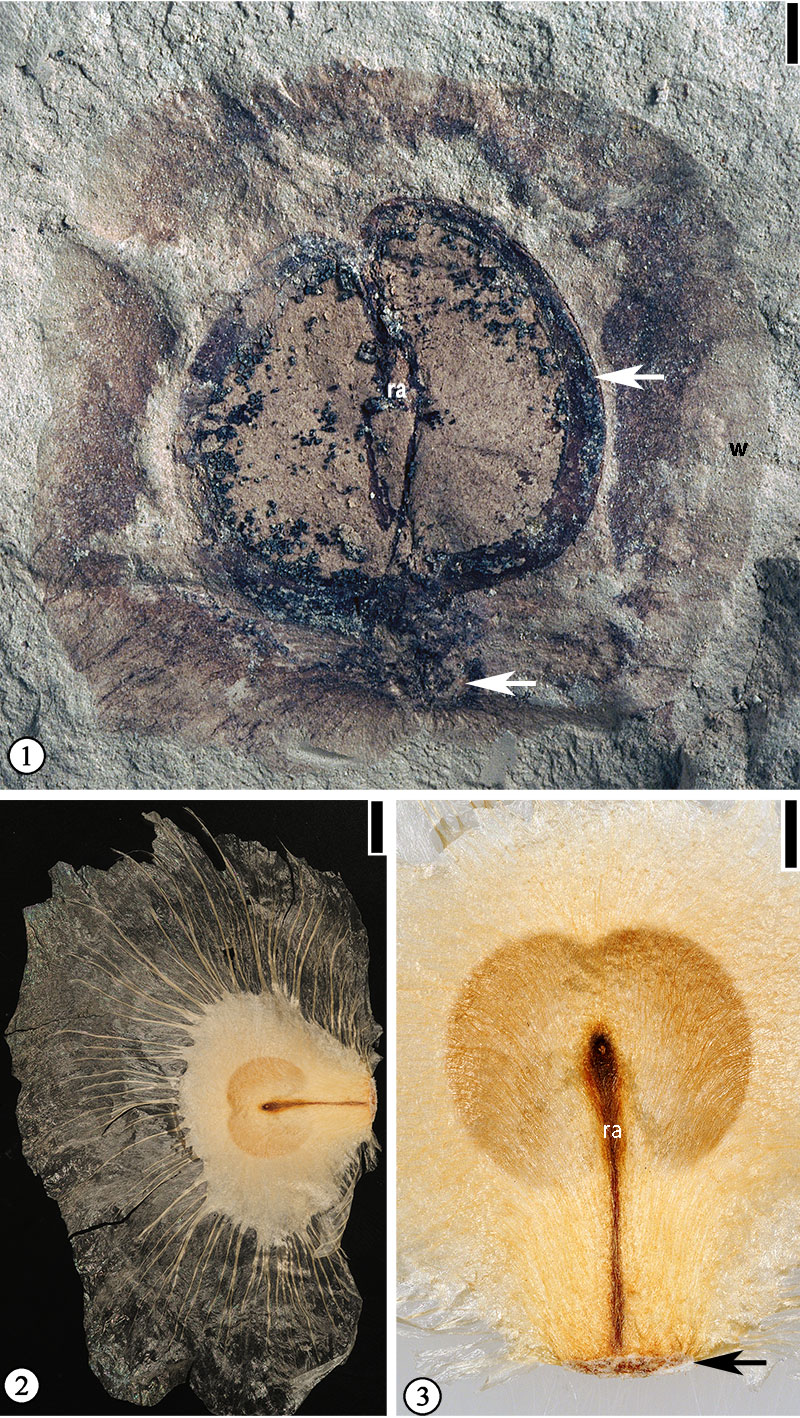
FIGURE 29. Fraxinus wilcoxiana (Berry) Call and Dilcher. All bars equal 3 mm. 1. UF15826-1368. Showing a calyx lobe (indicated by arrow on the left), a peduncle (indicated by arrow on the right), and thin subparallel veins on fruit wing. 2. UF15826-1369. Showing calyx lobes (indicated by arrows) and longitudinally striate fruit body.
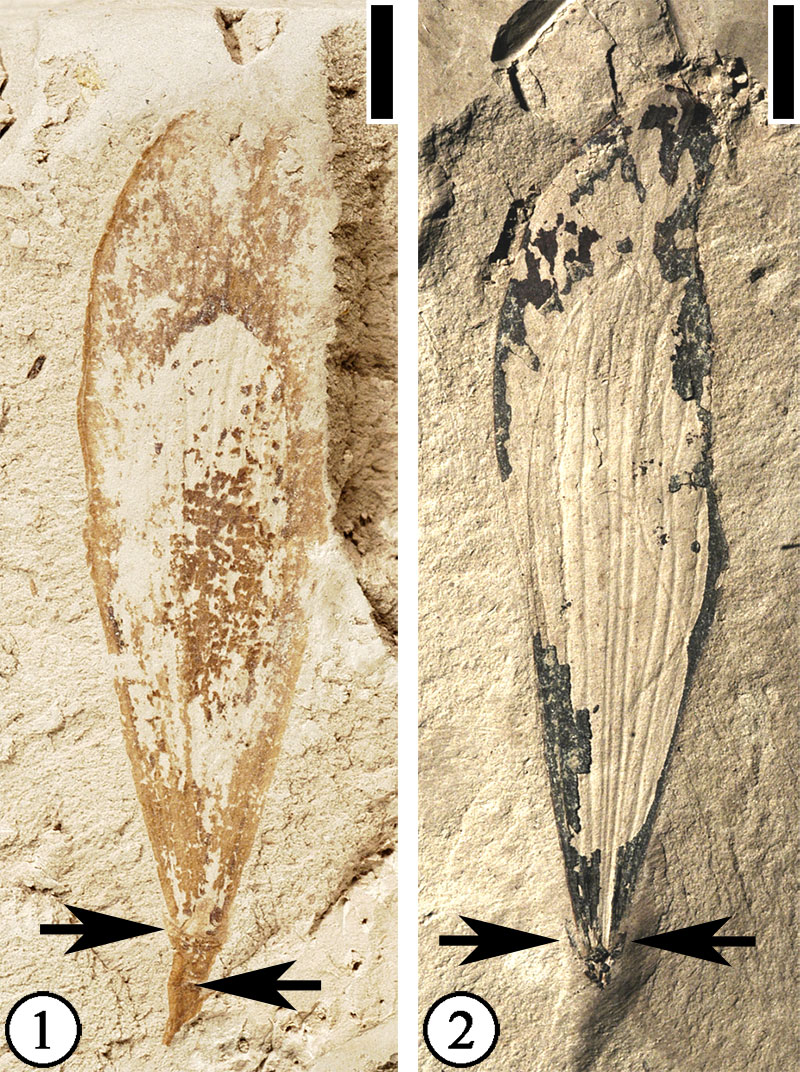
FIGURE 30. "Aralia" semina Berry. 1. UF15826-51298. A cluster of at least 10 seeds with the same orientation. Scale bar = 2 mm. 2. UF15826-51477a. An elliptic seed. Scale bar = 0.5 mm. 3. UF15826-51477b. A seed showing seven longitudinal striations and fine cross striations. Scale bar = 0.5 mm. 4. UF15826-51485. A wide elliptic seed. Scale bar = 0.5 mm. 5. UF15826-51550. A seed showing longitudinal striations and possible seed hilum on one end. Scale bar = 0.5 mm. 6. UF15826-51303. Narrow ovate seed with a prominent ridge in the middle extending to the mucronate apex, no prominent longitudinal striations but cross striations are similar to those observed in other "Aralia" seeds. Scale bar = 0.5 mm. 7. UF15826-51483. A specimen showing 12 dispersed seeds. Scale bar = 3 mm. 8. Enlargement of one seed from Figure 30.7 (indicated by arrow) showing longitudinal and cross striations. Scale bar = 0.5 mm.
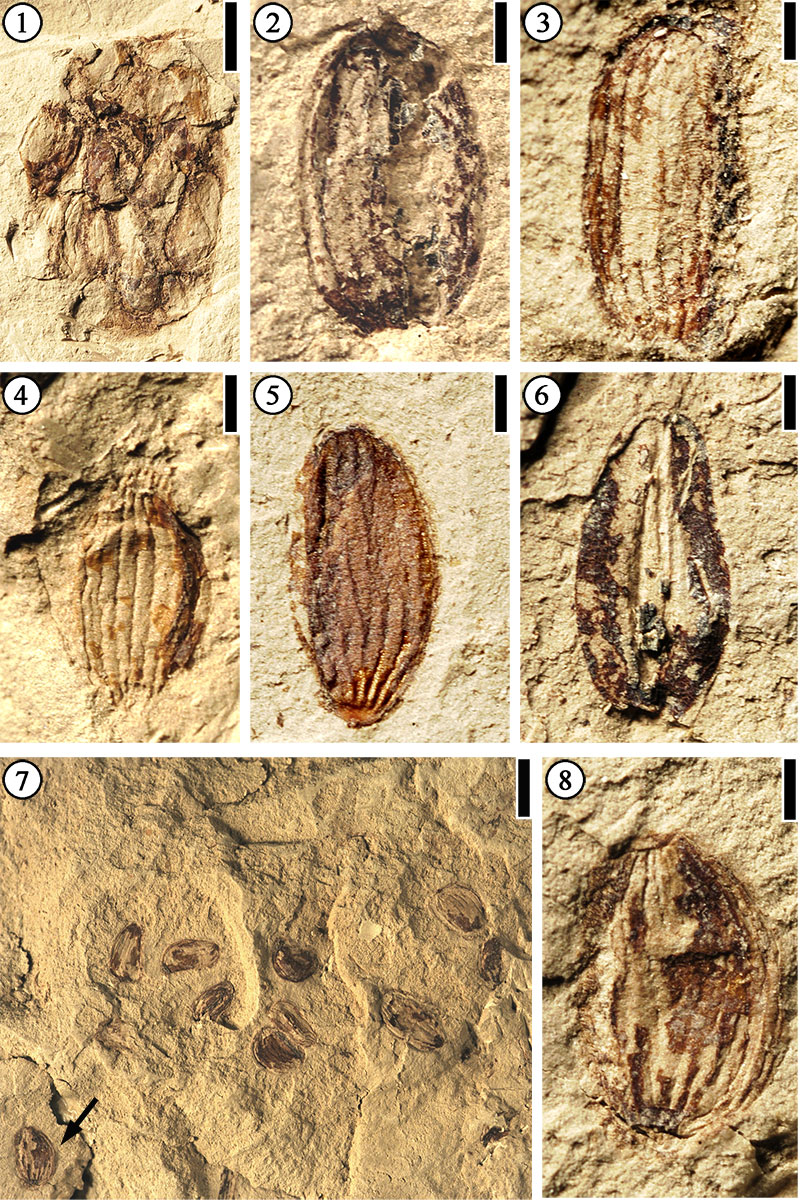
FIGURE 31. Infructescence Type 1. 1. UF15826-51472. Attached fruits at the distal portion. The depression in the center of a fruit (indicated by the arrow) may represent a hard seed of the fruit. Scale bar = 2 mm. 2. Enlargement of Figure 31.1 to show pedicels of shed fruits (indicated by arrows). Scale bar = 1 mm. 3. UF15826-51222. Distal portion of an infructescence. Scale bar = 2 mm. 4. UF15826-33570. An infructescence with at least 15 fruits. Scale bar = 2 mm. 5. UF15826-51440. An infructescence with impressions of at least 15 fruits. Scale bar = 3 mm.
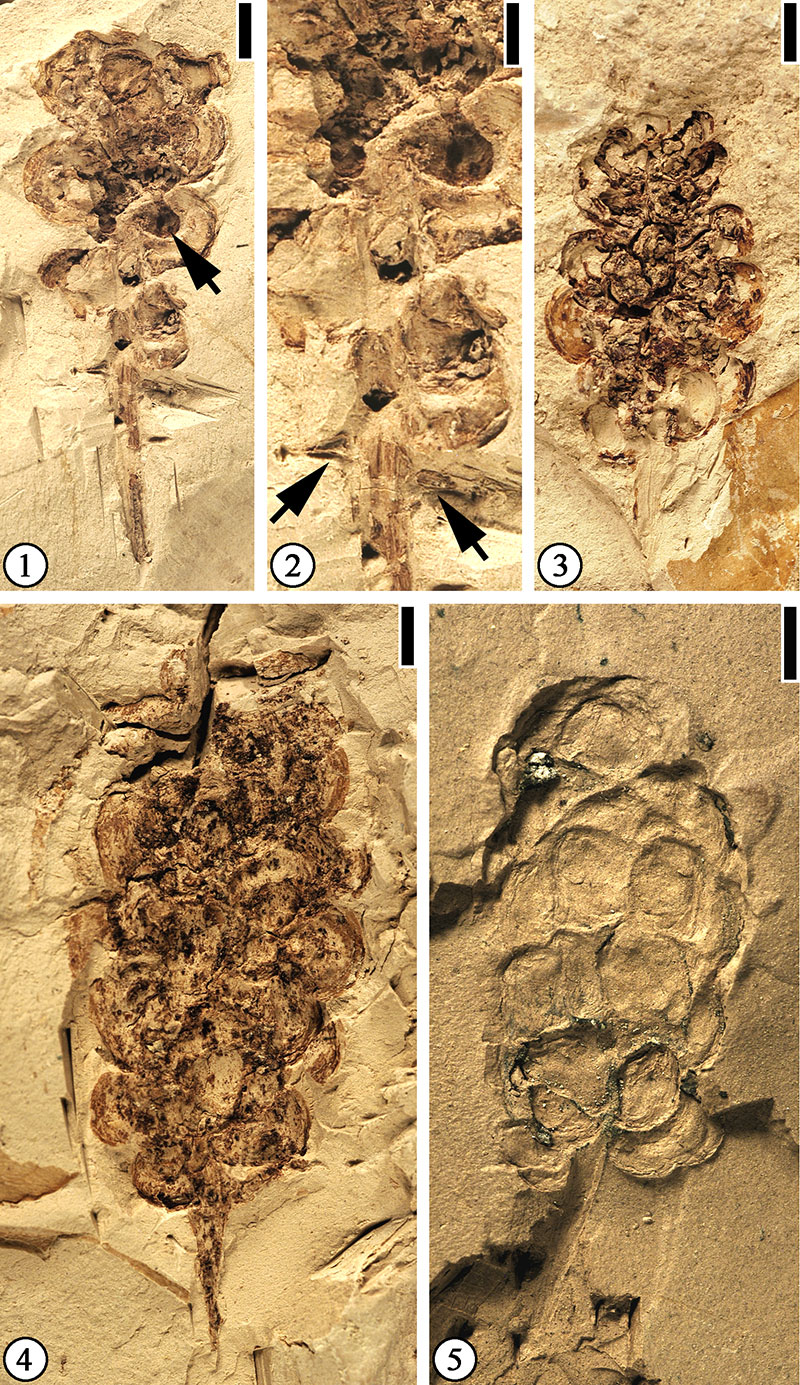
FIGURE 32. Infructescence Type 2. 1. UF15826-51525. An infructescence with about 7 attached fruits. Scale bar = 2 mm. 2. Enlargement of Figure 32.1 to show persistent styles on the fruits (indicated by the arrows). Scale bar = 1 mm. 3. UF15826-51296. An infructescence with a long peduncle. Scale bar = 2 mm. 4. Enlargement of Figure 32.3 to show clustered fruits. Scale bar = 1 mm. 5. Enlargement of Figure 32.3 to show impression of the appendage scars on the peduncle (indicated by the arrows). Scale bar = 0.5 mm.

FIGURE 33. Infructescence Type 3. 1. UF15826-51328. Impression of an infructescence and a long peduncle with smooth surface. Scale bar = 3 mm. 2. Enlargement of Figure 33.1 to show impressions of the bicarpellate fruits. Arrow indicates one of the two circular impressions within the larger pentagonal impression. Scale bar = 1 mm. 3. UF15826-51519. An infructescence and long peduncle with smooth surface. Scale bar = 3 mm. 4. Enlargement of Figure 33.3 to show impression of a central receptacle core. Scale bar = 2 mm.
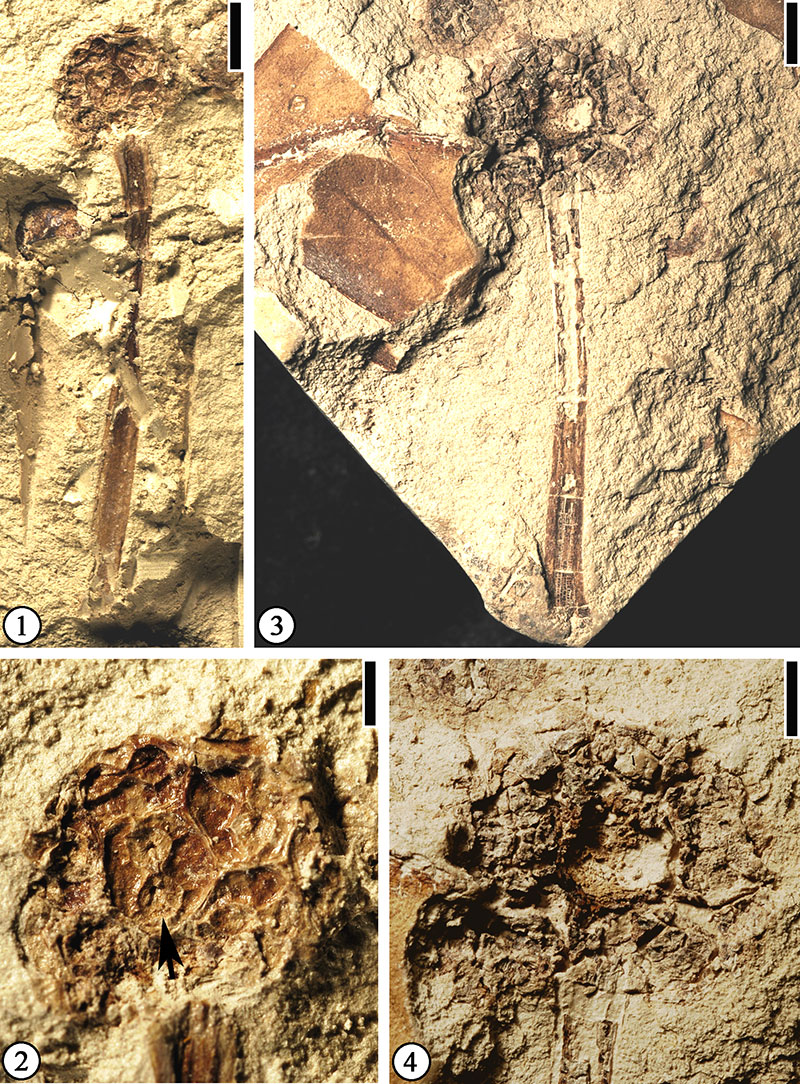
FIGURE 34. Antholithes wilcoxensis Berry. UF15826-33555. A flower showing five triangular perianth parts, an ovary, and a pedicel (indicated by the arrow; degauging confirmed that it is physically connected to the flower). Scale bar = 1 mm.
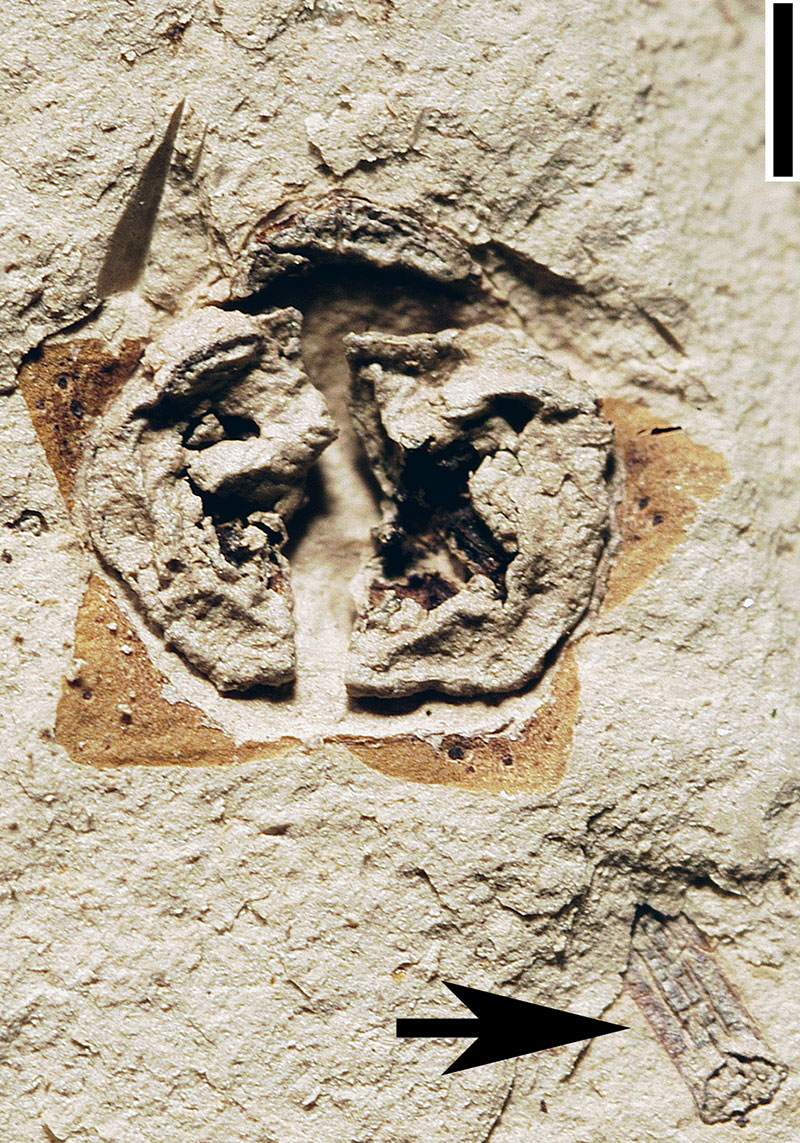
FIGURE 35. Solanites pusillus Berry. UF15826-33561. An incomplete specimen showing five separate perianth parts. Scale bar = 0.5 mm.
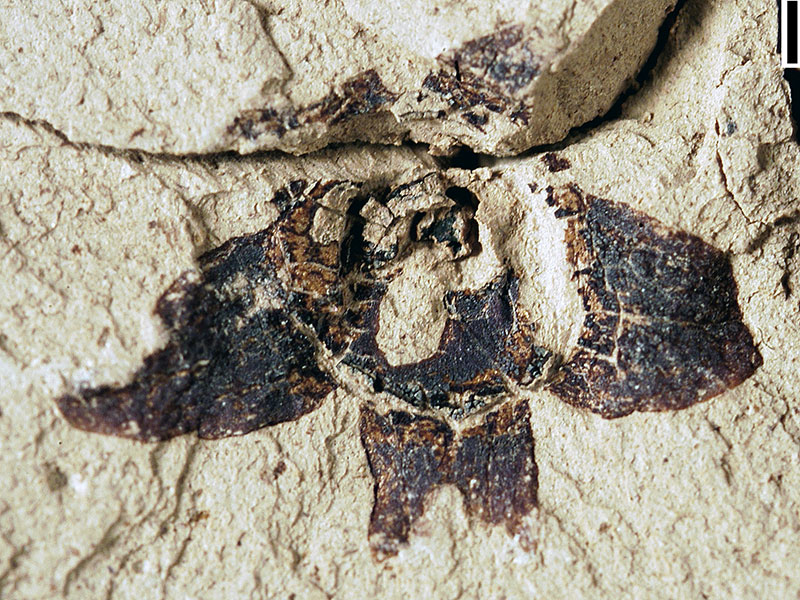
FIGURE 36. Floral Morphotype 1. 1. UF15826-33560. A laterally compressed flower showing three perianth parts fused at the base. The other two perianth parts are embedded in the matrix (indicated by two arrows). Scale bar = 1 mm. 2. Counterpart of Figure 36.1 to show hypanthium (indicated by arrow) and the fused perianth parts. Scale bar = 1 mm. Floral Morphotype 2. 3. UF15826-51276. A laterally compressed flower showing at least 5 perianth parts and an ovary (indicated by arrow). Scale bar = 2 mm. 4. Enlargement of Figure 36.3 to show trichomes on a perianth part. Scale bar = 0.5 mm.

FIGURE 37. Floral Morphotype 3. UF15826-33553. Five separate perianth parts and a small ovary. Scale bar = 0.5 mm.
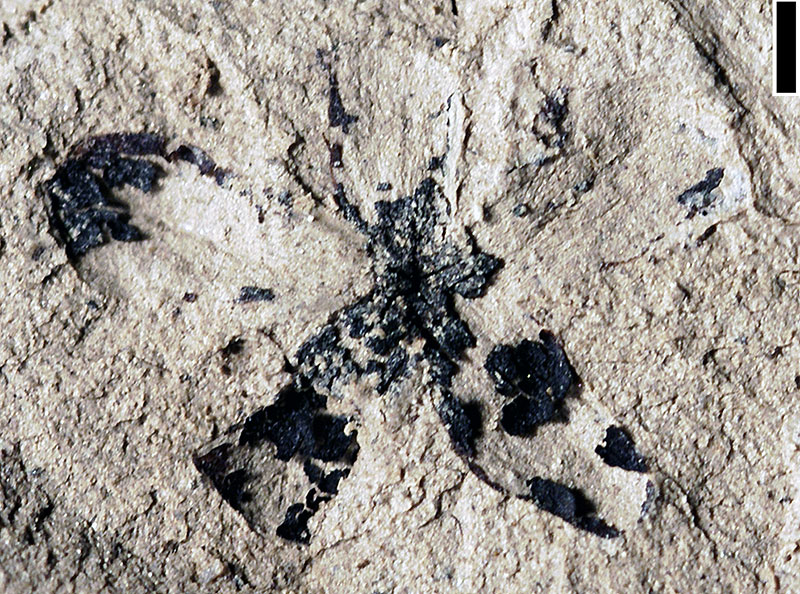
FIGURE 38. Floral Morphotype 4. UF15826-51304. A flower with five overlapping perianth parts. Arrows indicate positions where the perianth parts overlapp. Scale bar = 1 mm.
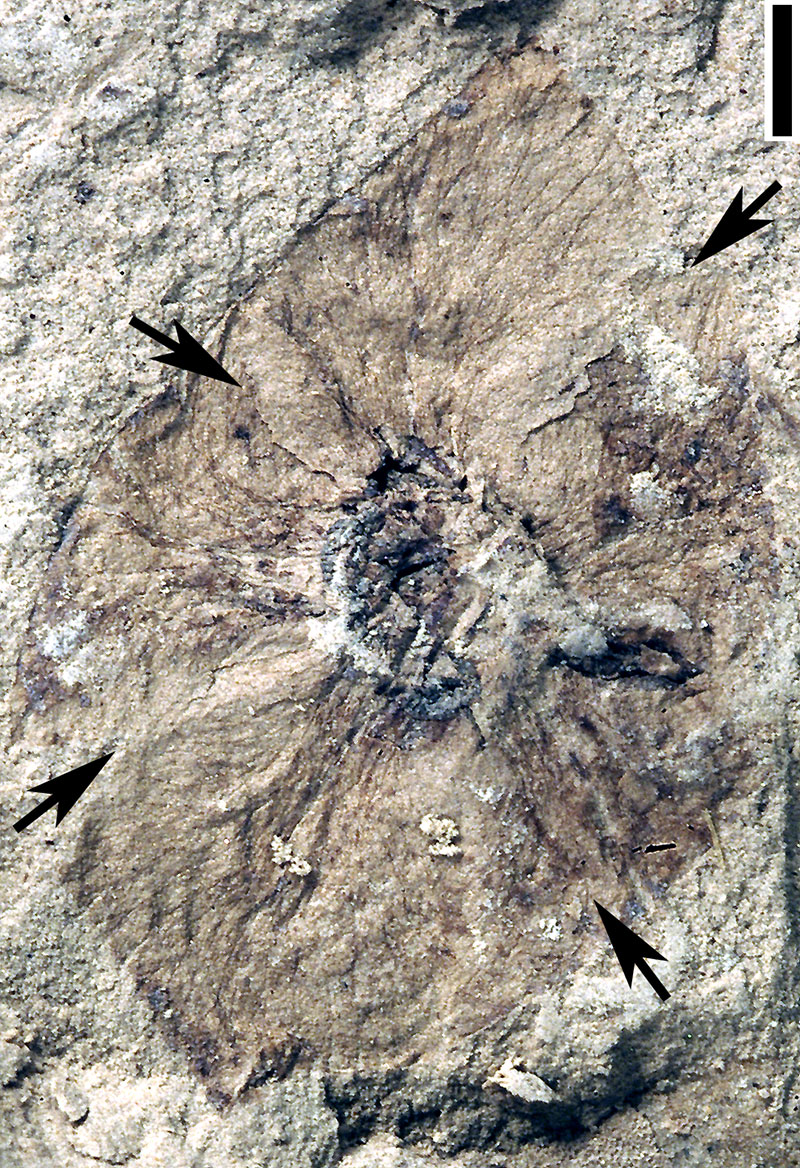
FIGURE 39. Floral Morphotype 5. 1. UF15826-5908. A superior ovary with 5-lobed gynoecium and surrounding perianth. Scale bar = 3 mm. 2. Counterpart of Figure 39.1 showing a receptacle and reticulate venation on perianth. Scale bar = 3 mm. 3. UF15826-33552. Five obovate perianth parts. Note parallel major veins of perianth. Scale bar = 4 mm. 4. UF15826-49556. A superior ovary with five radially arranged carpels. Scale bar = 3 mm.
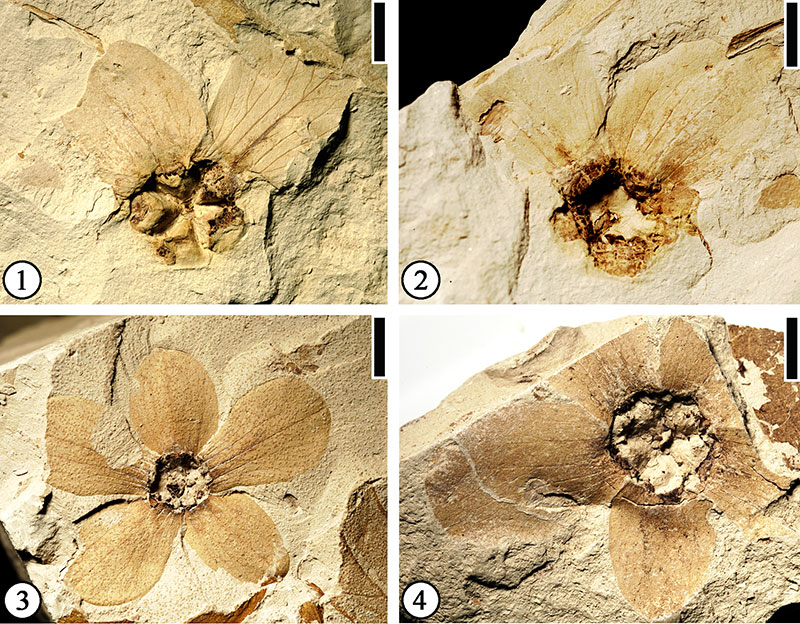
FIGURE 40. Floral Morphotype 6. 1. UF15826-51282. A flower bud with superimposed floral parts. Scale bar = 3 mm. 2. Enlargement of Figure 40.1 showing simple trichomes (indicated by arrow). Scale bar = 1 mm.
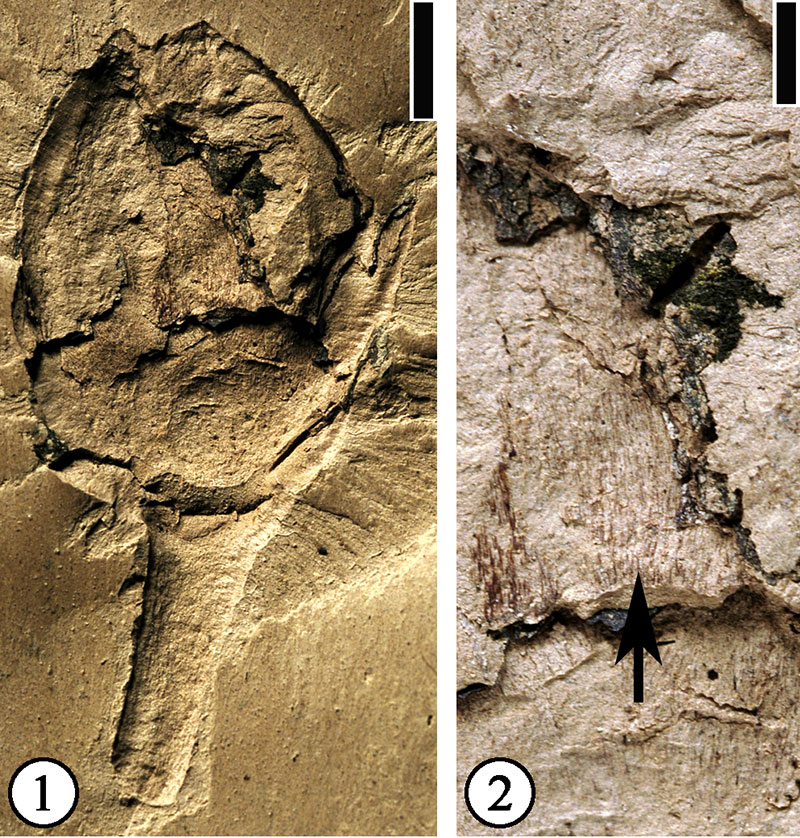
FIGURE 41. Carpolithus collinsi (Berry) comb. nov. 1. UF15815-6894. Showing an elliptic fruit. Scale bar = 4 mm. 2. UF15826-51487. Showing an orbicular fruit. Scale bar = 2 mm. 3. UF15826-51238. Note longtitudinal striations on the upper fruit body. Scale bar = 4 mm.
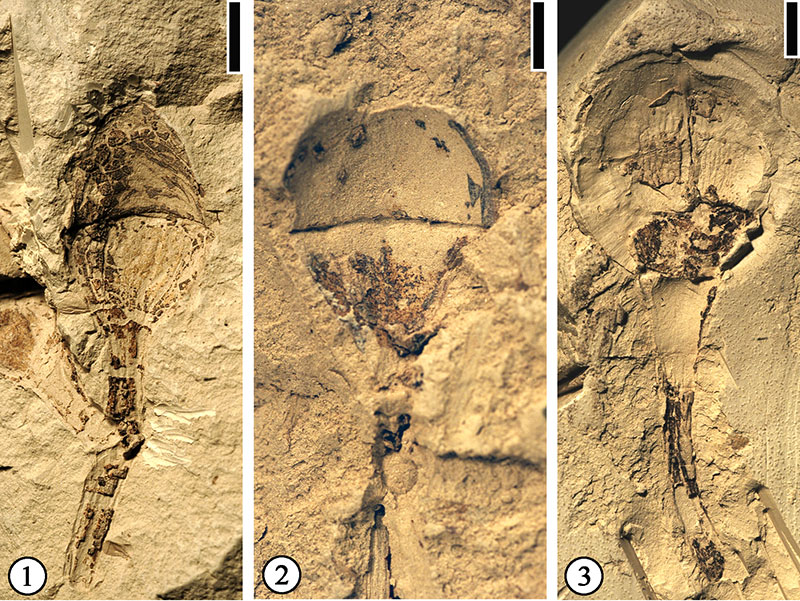
FIGURE 42. Carpolithus complanata (Lesquereux) comb. nov. UF15826-51486. An elliptic seed showing ridges and grooves. Scale bar = 1 mm.
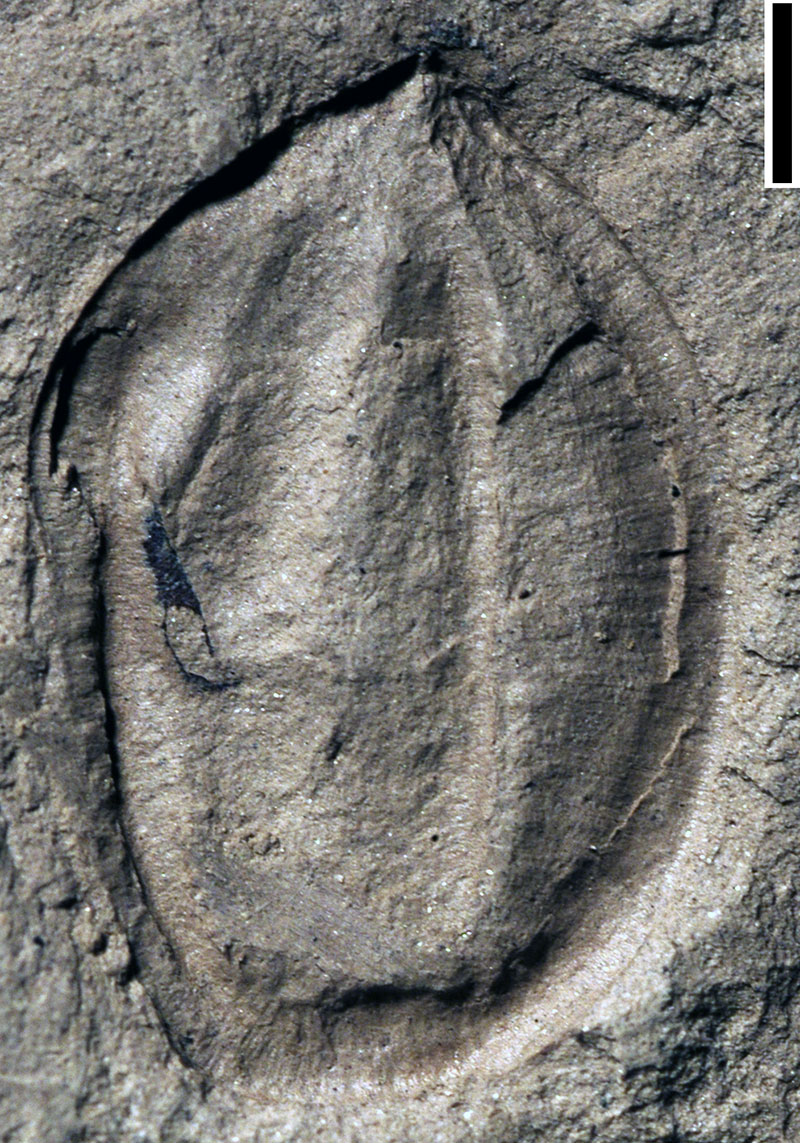
FIGURE 43. Carpolithus prangosoides Berry. UF15826-51403. Showing two lateral wings with reticulate venation, elliptic central body with longitudinal striations and a median ridge. Scale bar = 2 mm.
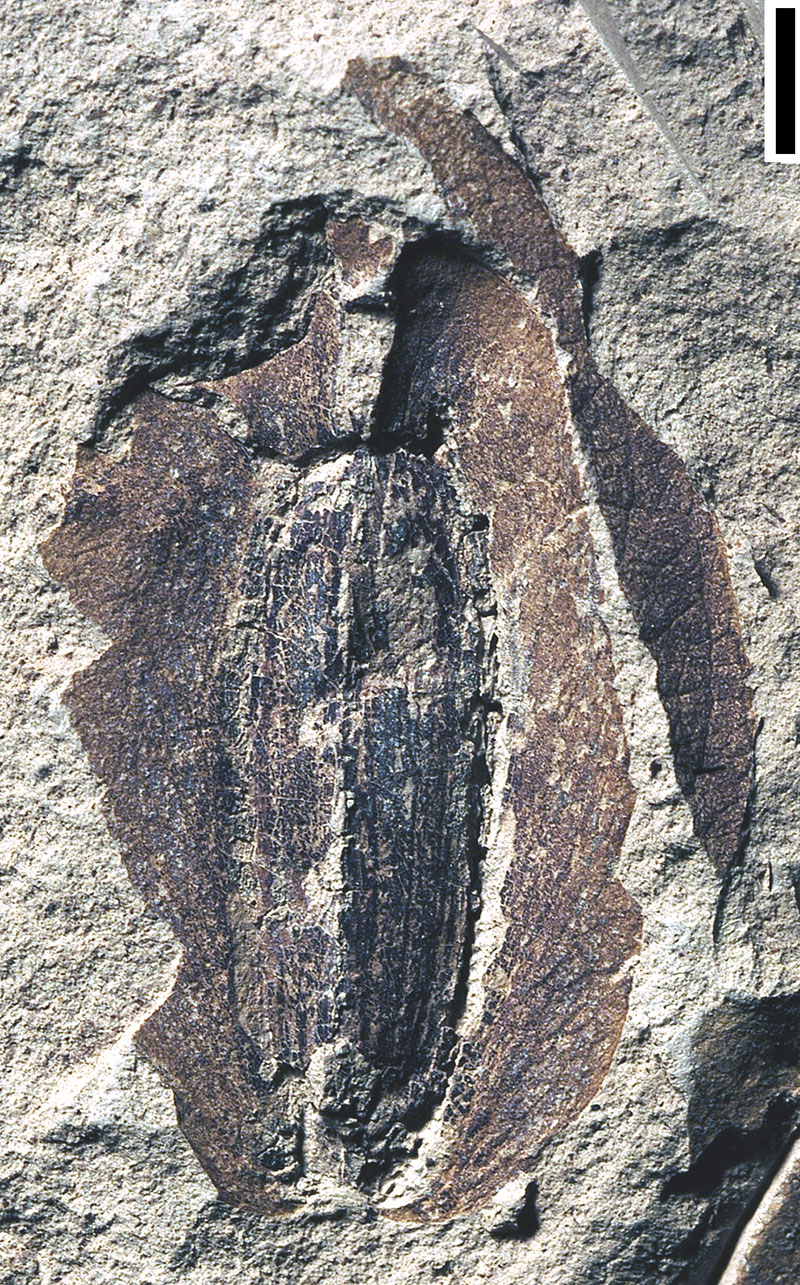
FIGURE 44. Carpolithus sophorites Berry. 1. UF15826-51382. A disseminule with a mostly missing thin wall and a central groove (g). Scale bar = 2 mm. 2. UF15826-51517. A disseminule showing a central groove (g). Scale bar = 2 mm. 3. UF15826-51545. A disseminule showing folding of a thin wall. Scale bar = 3 mm. 4. UF15826-51288. A disseminule with a groove (g). Note glands (indicated by arrows) on the disseminule wall. Scale bar = 2 mm.
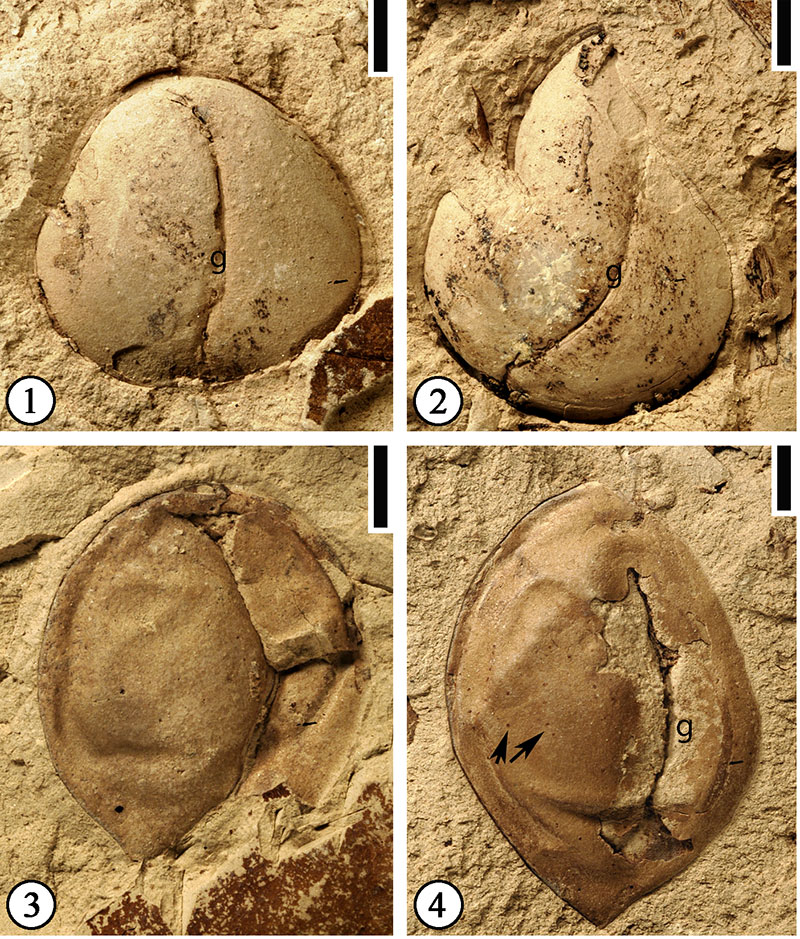
FIGURE 45. Carpolithus warmanensis sp. nov. UF15826-51471. A spiny fruit showing seed outline, laterally compressed spines on the left and vertically compressed spines on the right. Scale bar = 1 mm.
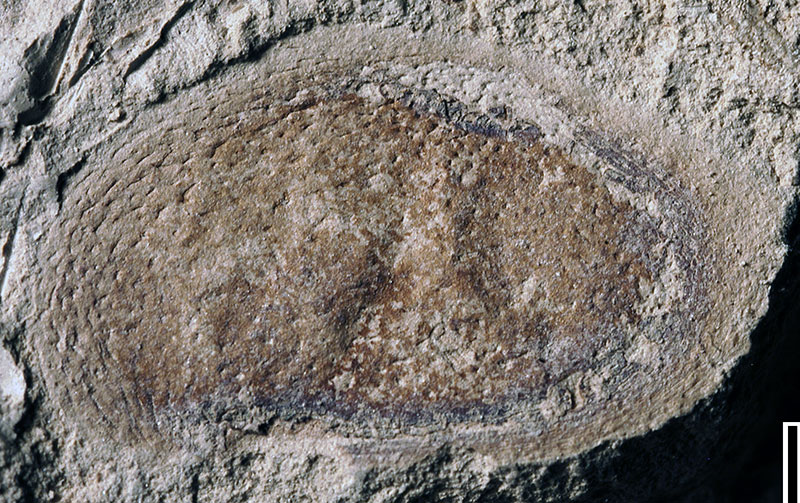
FIGURE 46. "Copaifera" yeguana Berry. UF15826-51465. A drupe-like fruit showing a depression where a presumed stony seed (s) was located and two projections on the exocarp (p). Scale bar = 2 mm.
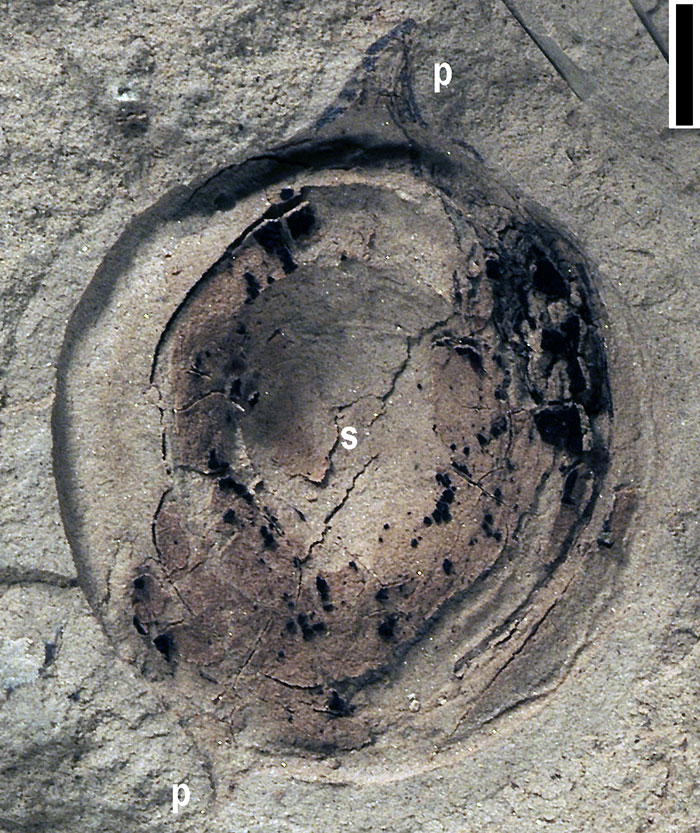
FIGURE 47. Palmocarpon wilcoxiana (Berry) comb. nov. 1. UF15826-51232. Mold of an elliptic fruit. Scale bar = 3 mm. 2. Counterpart of Figure 47.1 showing impression of an elliptic fruit. Scale bar = 3 mm. 3. UF15826-51400. A fruit showing longitudinal ridges and reticulate ornamentation. Note fine projections at the distal end. Scale bar = 2 mm. 4. UF15826-51334. An ovate fruit. Scale bar = 3 mm. 5. UF15826-51514. A fruit showing two strong longitudinal grooves. Scale bar = 3 mm. 6. UF15826-51459. A fruit showing longitudinal striations. Scale bar = 3 mm.
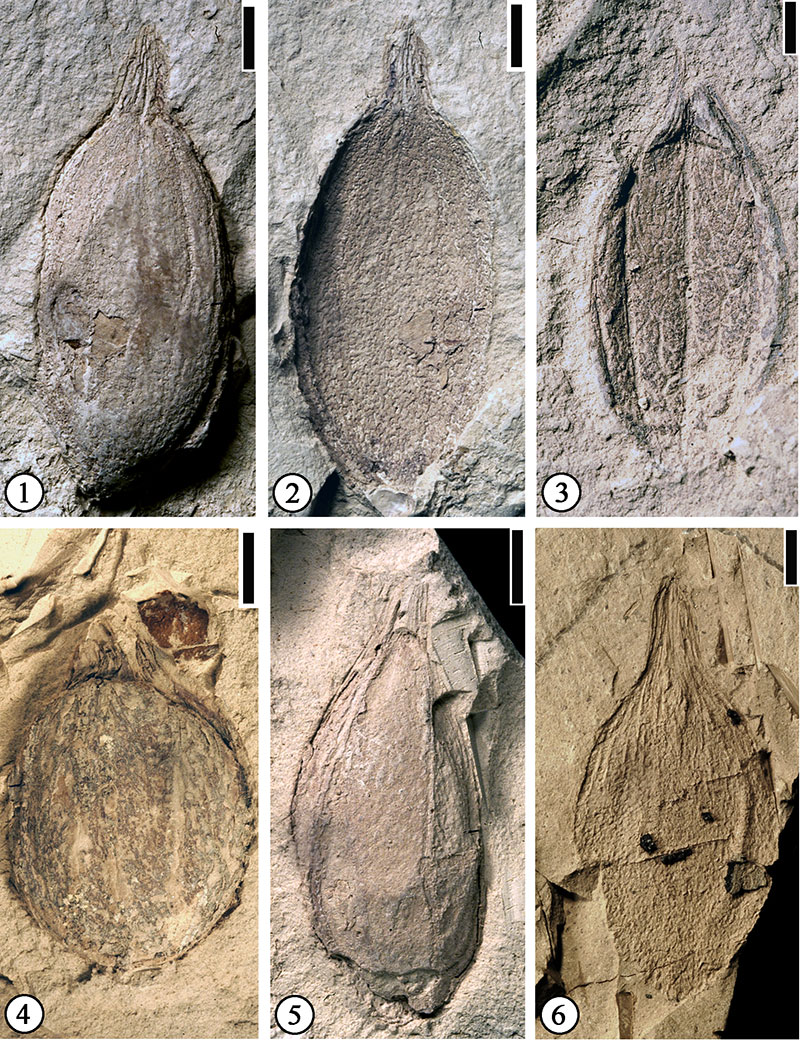
FIGURE 48. Palmocarpon wilcoxiana (Berry) comb. nov. 1, 2. UF15826-30831. Part and counterpart of a specimen showing longitudinal ridges and grooves. Scale bar = 2 mm. 3. UF15826-15438. An impression showing longitudinal ridges. Scale bar = 3 mm. 4. UF15826-51279. An asymmetric fruit. Scale bar = 2 mm. 5. UF15826-51338. A segment of a possibly dehisced capsule. Scale bar = 3 mm. 6. UF15826-15389. Another dehisced capsule. Scale bar = 3 mm.
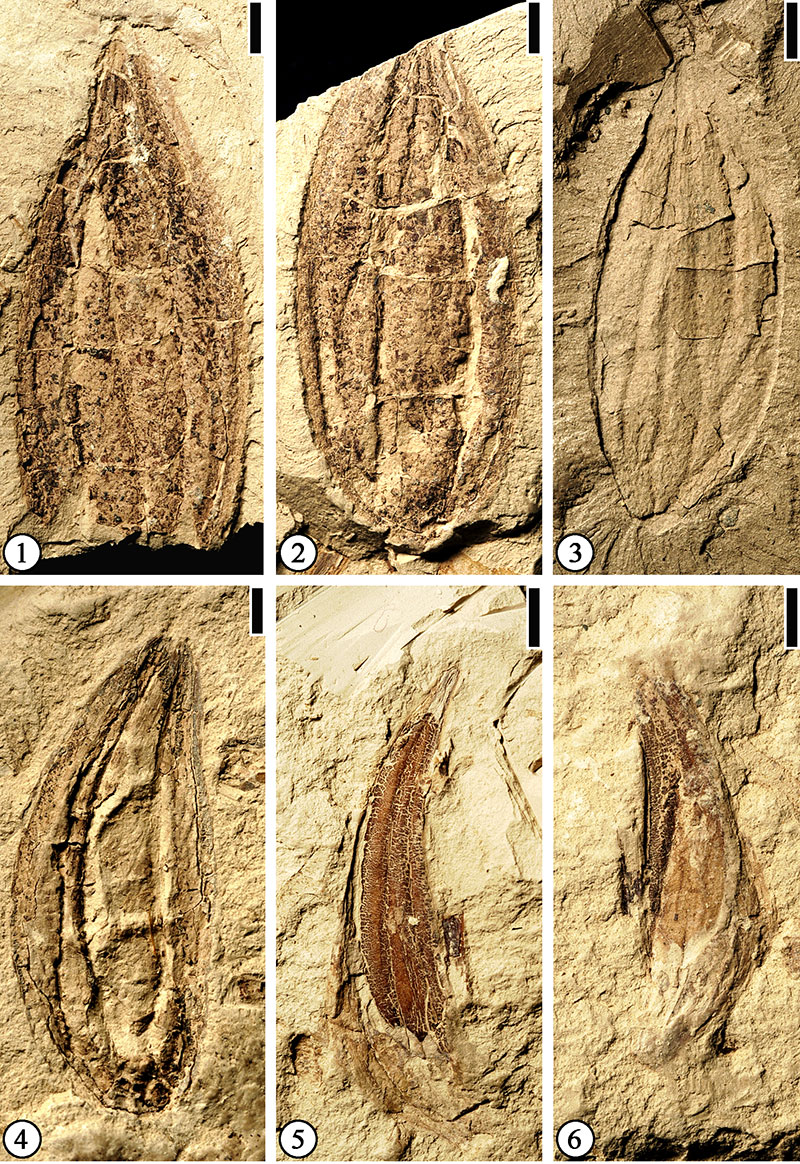
FIGURE 49. Sparganium sp. 1. UF15826-51260. Showing surface depressions and a stalk (s). Scale bar = 2 mm. 2. UF15826-51432. Showing surface depressions and projections. Scale bar = 1 mm. 3. Enlargement of Figure 49.2. Arrows indicate surface projections. Scale bar = 1 mm.

FIGURE 50. Fruit/Seed Type 1. 1. UF15826-51460. A capsule (c) with seeds removed. Note the receptacle (r) and the stalk (sk). Scale bar = 2 mm. 2, 3. Opposite sides of one seed removed from the capsule in Figure 50.1. Note the suture (s) on the seed. Scale bar = 1 mm. 4, 5. Opposite sides of the second seed removed from the capsule in Figure 50.1. Scale bar = 1 mm.
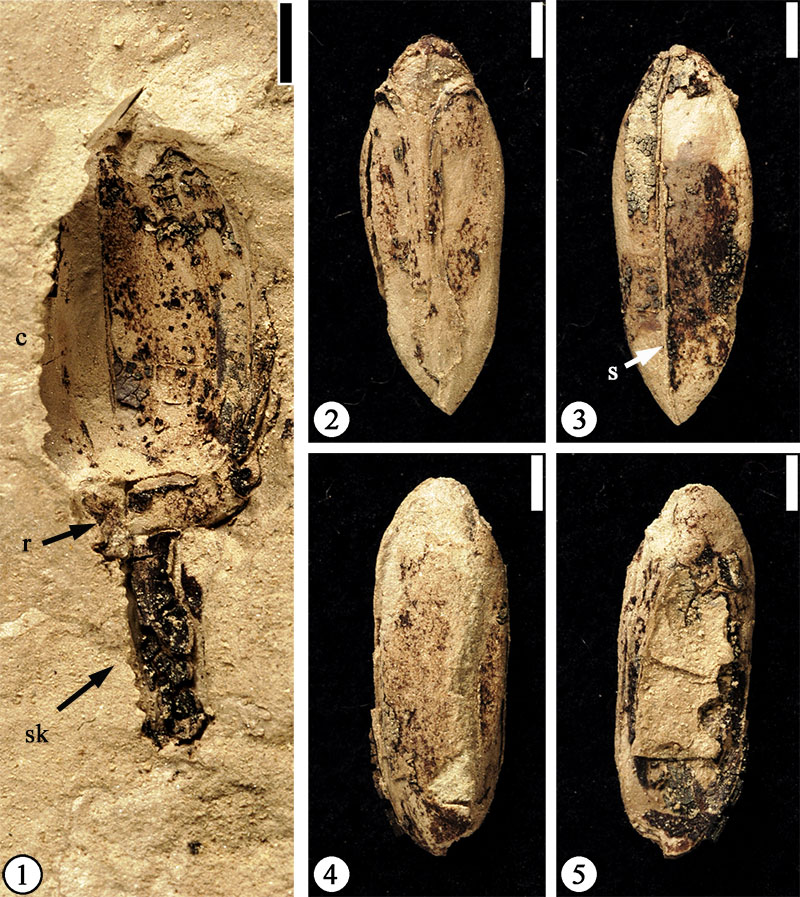
FIGURE 51. Fruit/Seed Type 2. 1. UF15826-51227. A laterally compressed receptacle and its appendages. Note one apically split appendage (indicated by arrow). Scale bar = 5 mm. 2. UF15826-51424. Basal view of a receptacle and its appendages. Scale bar = 3 mm.
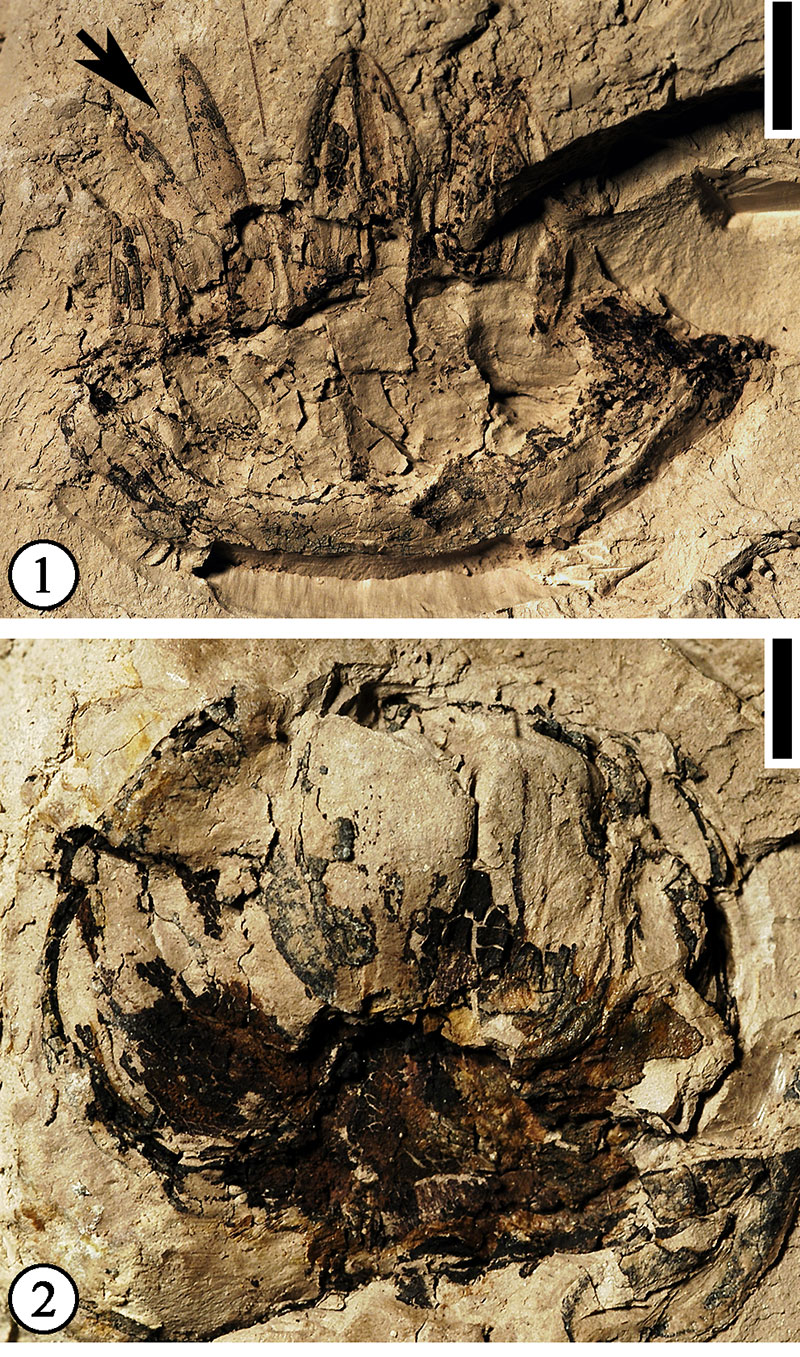
FIGURE 52. Fruit/Seed Type 3. All scale bars equal 2 mm. 1. UF15826-51503. Showing a thick seed coat and a smooth inner surface. 2. UF15826-51454. Showing the position of hilum (indicated by arrow). 3. F15826-51466. Showing the position of hilum (indicated by arrow).

FIGURE 53. Fruit/Seed Type 4. UF15826-51415. Showing an elliptic seed with a surrounding wing. Note the central groove (g) which may be the junction of the two cotyledons. Scale bar = 1 mm.
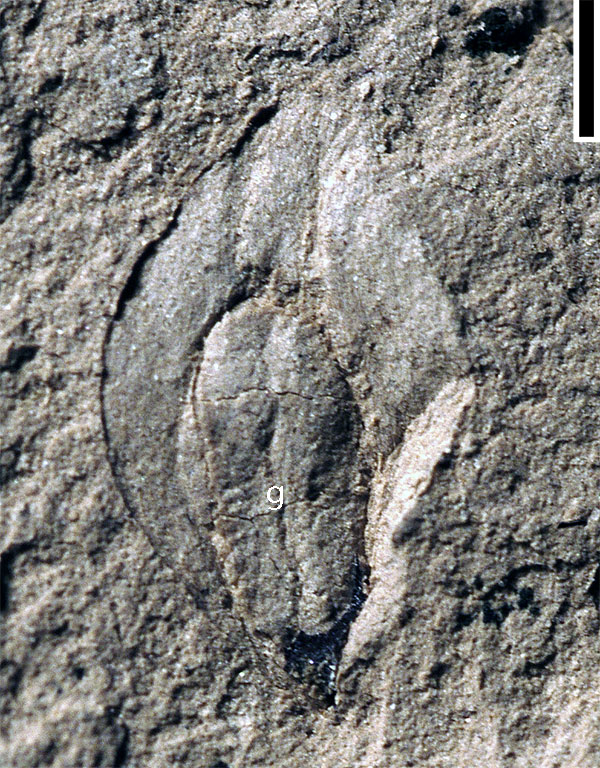
FIGURE 54. Fruit/Seed Type 5. All bars equal 3 mm. 1. UF15826-51425. A fruit with two valves (indicated by top two arrows) and stalk (indicated by bottom arrow). 2. Counterpart of Figure 54.1 showing two fruits. 3. UF15826-51427. Showing two fruits.
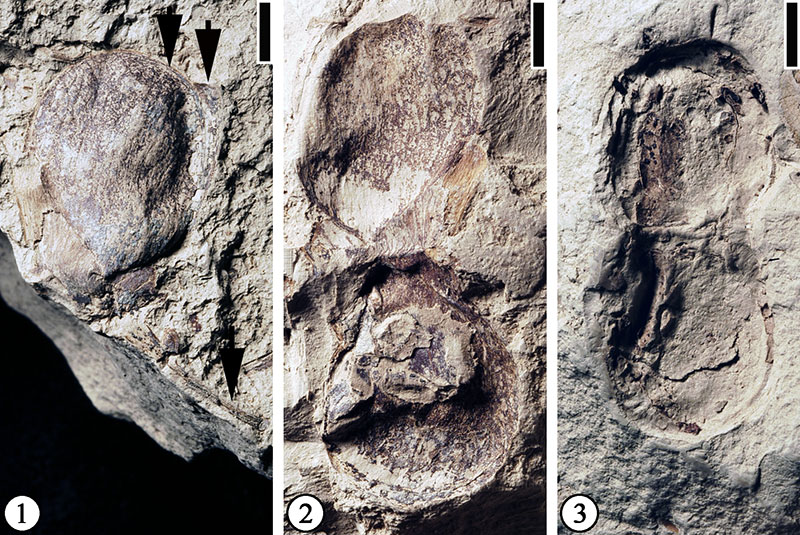
FIGURE 55. Equisetum? sp. UF15826-51391. Showing a cone-like structure and a peduncle with nodes and internodes. Note longitudinal ridges on the internodes. Scale bar = 2 mm.
